Two generations of battleships: On December 6, 1941, the US Navy was confident. Despite two coastlines to defend and a few overseas possessions, an opinion and a congress opposed to the war, the fleet’s hopes rested on no less than twenty battleships, at the time, the largest capital ships force worldwide: The Wyoming (2), New York (2), Nevada (2), Pennsylvania (2), New mexico (3) classes built before and during the great war, and the post-war Tennessee (2) and Maryland (4) which were of the late “super-dreadnought” type, plus the 1940 North Carolina (2), of the brand new “fast battleship” breed.
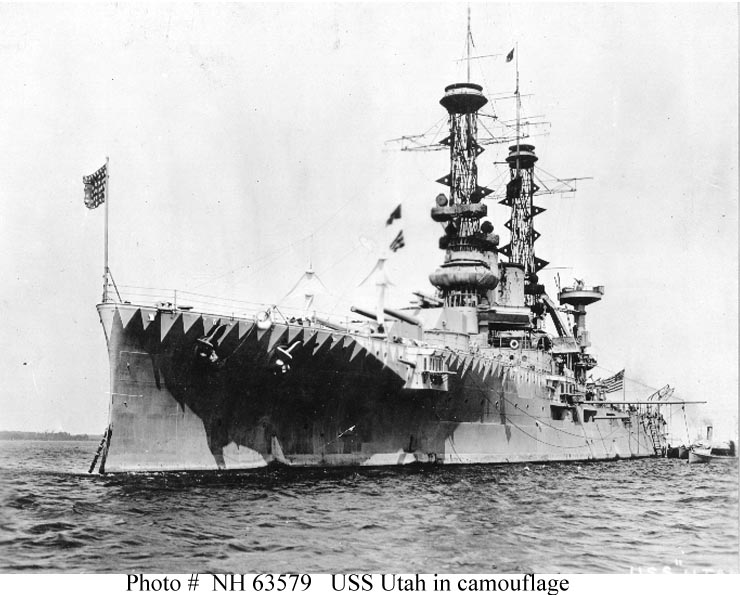
USS Utah in the Atlantic, camouflaged in 1918. This “old guard” was no longer in service in 1941. Utah was used as a target-ship in 1941.
The USN battlefleet in 1941
The US Navy started on the evening of December, 7, 1941, with a fleet virtually left with half of its battleships, notably the two recent North Carolina class, and WW1 veterans such as the Wyoming class, New York class, and New Mexico class. Meanwhil eight were on the bottom of Pearl Harbour, notably the famous “battleship row”, the two Tennessee and four Colorado, and USS Nevada. This was the entire Pacific Fleet’s main striking force. That was certainly as a major blow to any Navy and was certainly perceived as a catastrophe for the admiralty, but not only the aircraft carriers soon showed what they can accomplish, but the pacific losses only amounted to two total losses, the other six were soon rebuilt and modernized whereas another four modern super-dreadnoughts joined the fray in 1943, four more in 1944 largely making up for the losses.
This contributed to satisfy the ‘old guard’ of the Navy, those who knew the days of “great white fleet” in the shadow of Mahan, but not the youngest which saw in the carriers the new capital ships. If it was still not obvious in 1942, it became so in 1943. The last projected class of battleships, the Montanas and their staggering 70,965 long tons (72,104 t) fully loaded, were planned in 1940, postponed in May 1942, and eventually cancelled in July 1943, when the naval staff realized carriers should have now the priority.
The Iowa escaped cancellation only because it was believed the IJN had another pair of giant battleships in construction (which proved to be the Shinano and her uncompleted sister-ship), after the Yamato and Musashi. The irony was all three were sank by aviation, not other battleships. This did not prevented the four Iowa to see not only WW2 but also the cold war in its entirety until its conclusion and the 1990 gulf war, the last active battleships anywhere in the world and dinosaurs of a by-gone era.
The old guard: 12 Prewar veterans
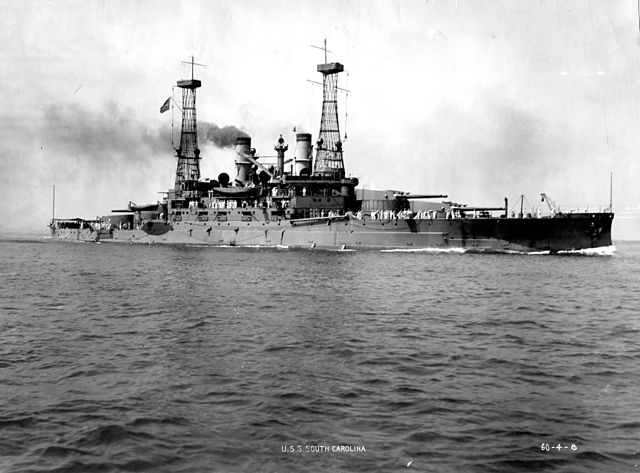
The USS South Carolina, first USN dreadnoughts in 1908. The design was compromised by a Congress drastic tonnage limitation.
In 1903 various bureaus were studying the possibility of cramming twelve 12-in guns onto a single hull, dispensing of the need of a secondary artillery. It should say that until 1903 it was believed (as shown by the war of 1898 and at Yalu in 1895), that battles would still be fought at close range in line with rapid-firing guns. The last pre-dreadnoughts thus, were given a powerful secondary battery, in addition to a tertiary one, and two to three levels below of even faster-firing anti-torpedo boat guns.
Maintenance and supply-wise it was nightmarish, and at long range, the water plumes resulting of these numerous calibers were hard to tell, attribute and correct fire. After the publication of Cuniberti, the monocaliber idea was made even more legitimate among American naval theorists. The battle of Tsushima was only the next indicator of the way to go.
The next battle was to convince the congress, and a compromise was found: They will authorize an intermediate, 16,000 tons battleship, not the scale of the HMS Dreadnought. Therefore the North Carolina could not match the firepower (with just eight 12-in) not speed of the dreadnought although considered as such.
However with the next Delaware Class (BB-28 and BB-29), part of the ambitious 1907 and 1908 Building Programs, the USN was given the first “true” dreadnoughts, with proper tonnage (20,000 tons), range, and speed (20 knots). In addition they had another turret, enabling a greater volume of heavy shell fire.
Congressional authorization did not specify a maximum size, freeing the Navy to make it be a quarter larger than their predecessors. Even the secondary battery was beefed up with heavier five-inch rather than three-inch guns. Triple-expansion and direct drive Curtiss turbines were also tested on each ship. Some issues has been underlined: Their secondary battery was “wet” (suffering from spray), their bow was low in the water, and the alternative project with wing turrets was not ideal as well, as these would have weaken the upper deck.
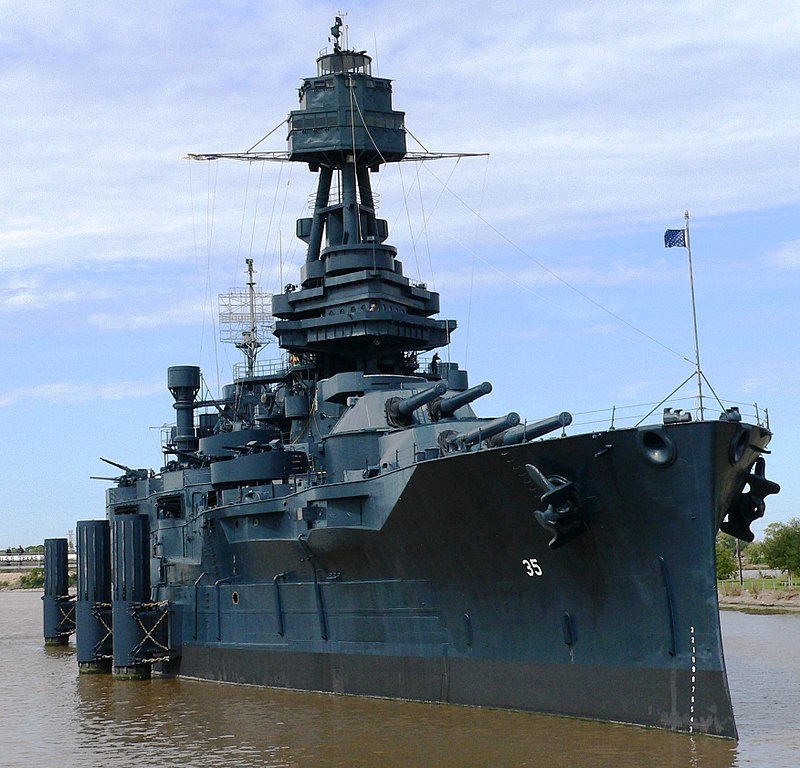
Preserved USS Texas, the last American dreadnought, here in navy blue 1943 livery.
The Florida class were basically a repeat, still one ship testing VTE and another turbines. Turret arrangement was the same, with axial ones instead of wing turrets like on British battleships. The Wyoming class of 1911 were only an incremental progress over the Florida, slightly larger, but with one more turret in a three axial superfiring pairs arrangement. The USN bureau asked for eight 14 in gun turrets, a compromise was found.
The next class however, the New York class in 1913 were the first USN battleship to feature the new 14-inch (356 mm)/45 caliber gun, a bit late compared to the Royal Navy. To the cost of one less turret, and return to a five axial turret configuration.
Before the next Nevada class, the class lacked anti-aircraft weaponry and armor layout was left to be desired.
The Nevada and ‘standard type’
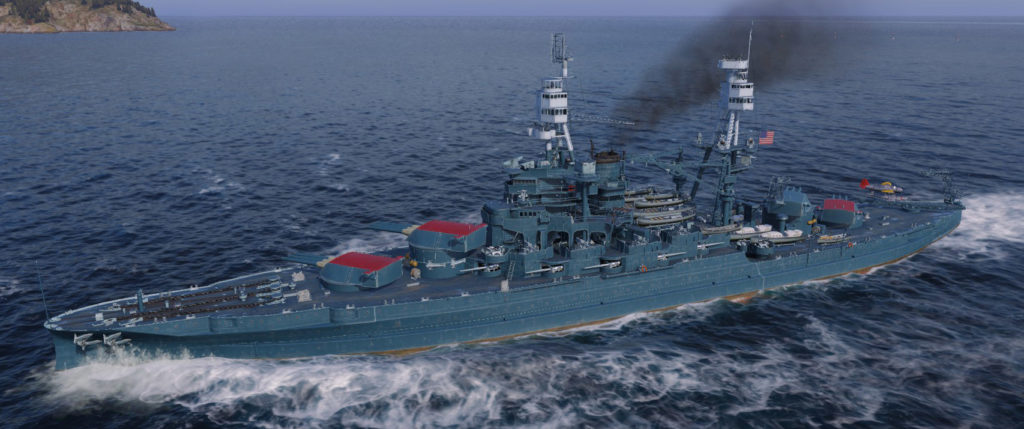
Wow’s Nevada underway, in her Dec. 1941 livery
The Nevada were a leap forward in many directions. They were also quite active during WW2.
They were the first ‘Standard-type’ battleships of the USN, carrying twin and triple turrets in superfiring pairs to maximize firepower in chase, retreat, and broadside without compromises. To preserve speed, the armour was of the “all of nothing” scheme. They were designed to fight at extreme gunnery range, and actually well ahead of their time. To them succeeded the similar Pennsylvania, New Mexico, Tennessee and Colorado. The Nevada compromised with lower triple turrets, and upper twin turrets, all with 14-in guns, so ten in total.
However the next three swapped on all triple turrets arrangements. The New Mexico innovated with a new clipper bow, for better seakeeping and a sleeker look, while the USS New Mexico herself tested a turbo-electric arrangement for the first time. Also the class comprised three ships. The idea was one was based in the Pacific fleet, one in the Atlantic at all time while the third could be in drydock for maintenance and used as a “joker” to replace either of the two. However eight of the secondary battery guns were found quite “wet” and were removed afterwards. Needless to say, all these standard ships were also considered “super dreadnought”. The name was introduced after the British HMS Orion class, 2000 tons heavier, faster, and with a 14-in artillery.
The last super-dreadnoughts (1918-23)
The next Tennessee and Colorado classes were considered as the last American “super-dreadnoughts” by many authors. The class reverted to two ships only, with the same armament and clipper bow as before, but they innovated with a significantly strengthened underwater protection system, and increased elevation of the main battery guns for longer range fire. The USS California was laid down in October 1916, so long after the battle of Jutland, allowing to integrate a few lessons of the battle into the design, although the design was made in peace time. They were also the first American dreadnoughts to miss the great war and serve only in WW2.
A last-minute change made the the Colorado class both return to eight guns, but jumping to the next caliber (16 in or 406 mm) but they were essentially repeats of the Tennessee. Laid down when the USA were at war with Germany, they were still designed to be integrated in a battle line as “standard” battleships. Of course, they were launched when the war ended and completed in the early 1920, do of the four planned vessels, the fourth, USS Washington was cancelled and broken up, under provision of the Washington treaty in 1922.
The next South Dakota class also cancelled would have been a departure of this standard and a new step in the “super-dreadnought” genre, with triple 16-in turrets, four of them, calling for nearly 48,000 tons of displacement, and 23 knots, two more than the Colorado. This escalation was precisely what needed to be stopped by the treaty, in a war-torn, impoverished and reconstructing world.
“hyper-dreadnoughts”: The South Dakota class.

The four South Dakota battleships were to be the ultimate dreadnoughts built by the US Navy. The Washington Treaty intervened long before the ships were completed. This class was to comprise no less than 6 ships, the USS South Dakota, Indiana, Montana, North Carolina, Iowa and Massachusetts. It could be summarized as much larger Tennessee-class carrying the Colorado guns, ie triple turrets with 16-in guns (406 mm), quite a massive firepower.
Moreover, the design bureau wanted a departure from the standard class and a top speed of 23 knots, thus imposing a displacement of 43,200 tons empty. Although a massive stop forward, it was not outlandish compared to Japanese projects of the time.
Apart from their larger dimensions, these ships would have been recognizable by their truncated funnels and corbel masts. Construction was cancelled in February 1922, none were completed as aircraft carriers as their speed was deemed too low.
The American battlecruisers.

Another interesting development of this 1919 battleship race was the only attempt of the USN to design and operated battlecruisers. The great war showed indeed a real interest emerge for these ships, probably the most often committed in battles and operations. Speed indeed was a tempting asset to use. So the USN at war in 1917 now had free hands to study a type of ship that was more aggressive and did not fare well with the more defensive nature of the classic battleship fleet, more for a projection of power and dissuasion. Like cruisers, battlecruisers were to forage deep in enemy waters, seeking contact at a time naval aviation for reconnaissance was sill not well integrated.
The development story of this class was quite long, and the six Lexington class were essentially planned after the Battle of Jutland, showing that the protection of battle cruisers was essential. As a result, these Saratoga were much better protected, while also having more powerful weaponry and still high speed. A quadrature of the circle resulting in prodigiously large units, flirting with 60,000 tons. The Lexington’s final design as approved was to comprise eight 18-in (457 mm) guns, the new heavy standard considered by the Japanese and the British at that time.
But the latter involved a colossal displacement. The cannons alone weighted two times more than a 12-in gun, imposing a massive turret. Planned like the South Dakota class battleships, the five Lexington-class battlecruisers (Lexington, Saratoga, Constitution, Constellation, United States) were to be completed in 1922-23. They were of course cancelled due to the Washington Treaty suspension in 1923. They should have been scrapped, but whereas their hulls were already well advanced, the Lexington and Saratoga were converted into aircraft carriers after years of studies. An ideal choice because of their large size and speed. They became therefore the first fleet aircraft carriers of the US Navy.
Interwar developments 1925-36.
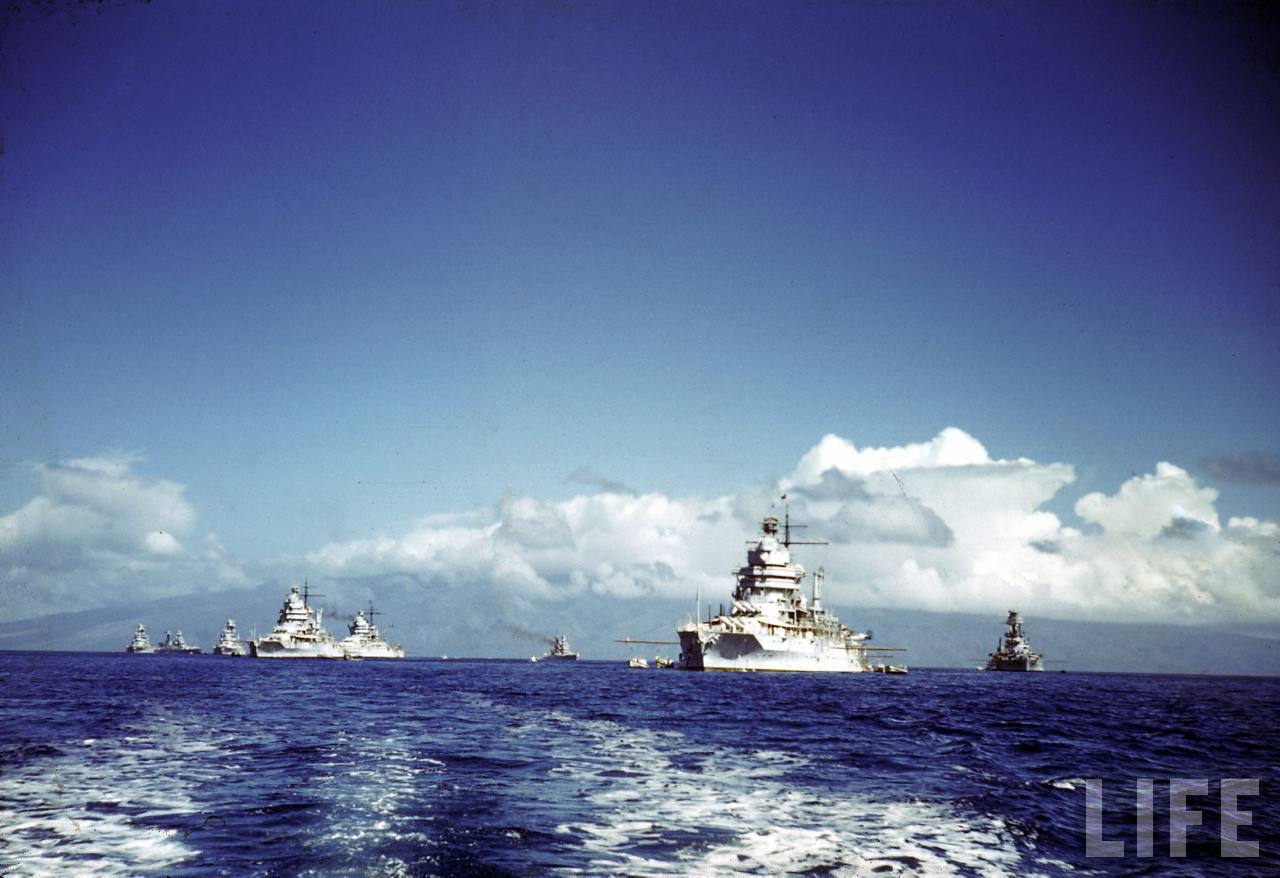
The USN battlefleet in 1941 (LIFE magazine).
The treaty of Washington in 1922 drastically reduced the size of the battle fleets by global tonnage but also the individual ships of all classes but submarines and aircraft carriers.
The losses of Pearl Harbor
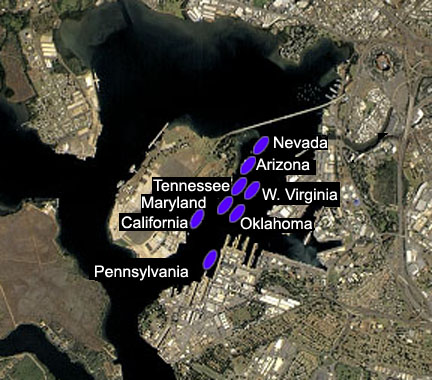
Many works and studies has been done about the monumental attack which changed history. There was plenty of evidence the attack was not only possible, but self-evident and almost awaited. Conspiracy theories aside, bearing in mind President Roosevelt’s personal view of the war in Europe and US isolationism, this attack was not avoidable either. Like any catastrophe, the failure to prevent the attack and the losses were due to a number of factors: US Intelligence services unable to locate the IJN fleet, which was known to have sailed towards the central pacific from Kure. Failures with the early radar operators, which mixed an arrival of B-17s from the continent to the approaching Japanese aviation.
Failure by early spotters, including a training plane, to report this aerial armada, objective lack of preparedness this Sunday morning, easy picking of the aviation, not protected in individual positions but out on the open to watch them over saboteurs. Failure for the fighters to take off and defend the harbour, insufficient AA cover in general of the harbour, as well as inadequate AA on USN Battleships.
But there was also luck in this: The absence of the only three pacific fleet aircraft carriers this very day. The unwillingness of Kurita to authorize a third wave, notably targeting the fuel tanks, estimating the surprise effect was lost…
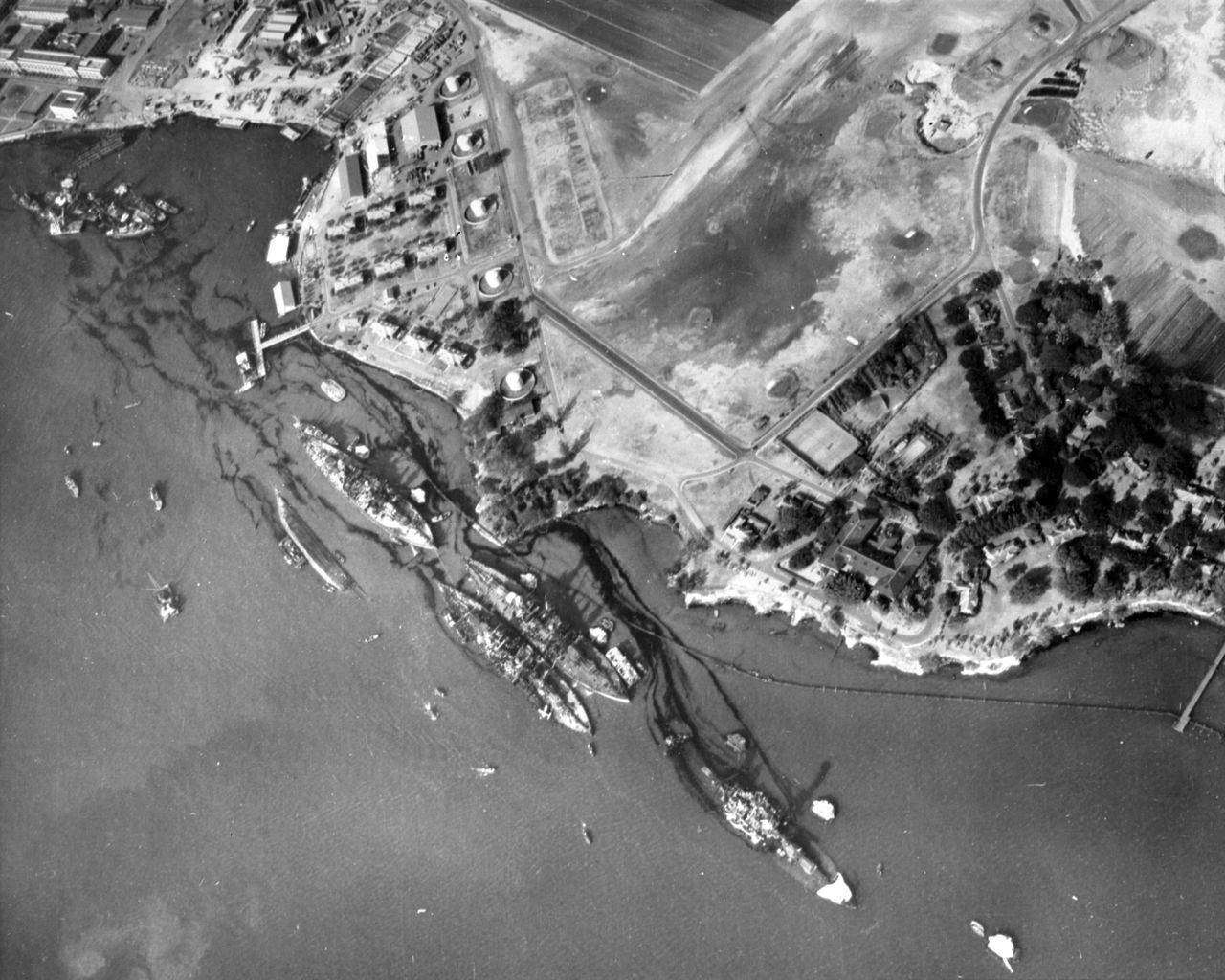
The Japanese air attack did not came out of the blue of course, it’s main inspiration was the November 1940 attack on Taranto, one year earlier. Though using only a few “stringbags”, the Royal Navy night attack crippled the Italian fleet for month. Such attack, with not a single, but six carriers, and more than 300 planes of all types, torpedo-carriers, dive bombers and escorting fighters, was well able to take care of the much larger USN Pacific fleet. The great difficulty (there were many) was to sneak with a much massive fleet in the Pacific, from Japan to Hawaii, 6,611 km (3570 nautical miles) undetected.
The Arizona, flagship of Battleship Division One, was hit by an armor-piercing bomb which exploded inside an ammo room, with a total loss of 1,177 dead, most of the crew, part from the expulsion and most drawn when the ship capsized. Terminal constructive loss, now a memorial.
USS Oklahoma was hit by five torpedoes and capsized becoming a total loss with 429 dead. However she was refloated in November 1943, but decommissioned on 1 September 1944, and later capsized and lost under tow in May 1947. She never saw action in WW2 but her short fight in the harbour.
The USS West Virginia was hit by two bombs and seven torpedoes (106 dead). She sank, was refloated, repaired, and rebuilt. She eventually returned to service July 1944 and was part of many combined operations.
USS California was hit by two bombs and two torpedoes (100 dead) and sunk. Refloated, repaired and rebuilt, she returned to service in January 1944.
USS Nevada was hit by six bombs, one torpedo (60 dead). She was beached and therefore saved. Quickly repaired and rebuilt, she returned to service as early as October 1942.
USS Tennessee was hit by two bombs (“only” 5 dead), quicky repaired and rearmed, returning to service as early as February 1942. USS Maryland was hit by two bombs and also quickly repaired. She returned to service also in February 1942. For the anecdote, one of her four victims was the floatplane’s pilot that took off and attempted to shot down Japanese attack planes, and fell victim to Zero fighters. The USS Pennsylvania was the flagship of the U.S. Pacific Fleet) and in drydock with Cassin and Downes when the attack took place. She was hit by one bomb and debris from USS Cassin. She was quickly repaired and remained in active service. USS Utah at last, was hit by two torpedoes and capsized (64 dead). A total loss, she was as a target ship, docked on the west side of Ford Island. Therefore of little value she was left in this state.
Wartime fast battleships
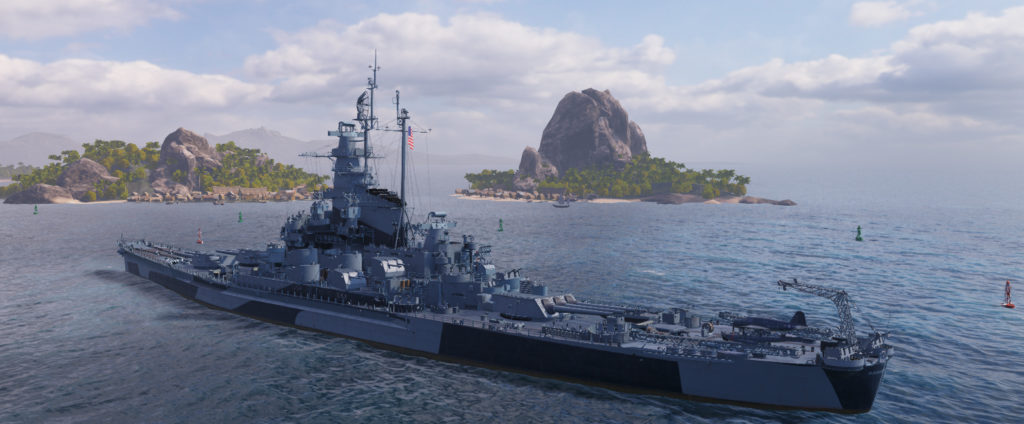
USS Massachusetts (wow’s rendition) as she was in 1944.
The genesis of the North Carolina class Battleships is quite an interesting one. After the end of the the great war, expanded naval construction programs bumged a considerable way, and the US’ 1916 program called for six Lexington-class battlecruisers and plus South Dakota-class battleships. However by December 1918, Woodrow Wilson’s government asked for an additional ten battleships and six battlecruisers. The General Board proposed on its side two battleships and a battlecruiser for FY1921, plus three battleships, a battlecruiser, four aircraft carriers and thirty destroyers in FY 1922 and 1924. The UK was planning the G3 battlecruisers, N3-class battleships, while Japan was busy laiying the keels of Nagato, Tosa, Amagi, Kii and Number 13 classes, with the last class started in 1928.
However these staggering costs pushed Secretary of State Charles Evans Hughes to invite delegations from the major maritime powers in Washington, D.C. to end the current naval arms races. The 1922 Washington Naval Treaty provisioned a standard displacement for battleships of 35,000 long tons (36,000 t), maximum gun caliber of 16-inch, and geeral tonnage limitations. The five concerned naval powers would have to acccept a construction holiday of ten years with no replacement for ships not aged at least twenty years old. The 1936 Second London Naval Treaty restricted gun size on new warships to 14-inch, and both influenced the design of the North Carolina class.
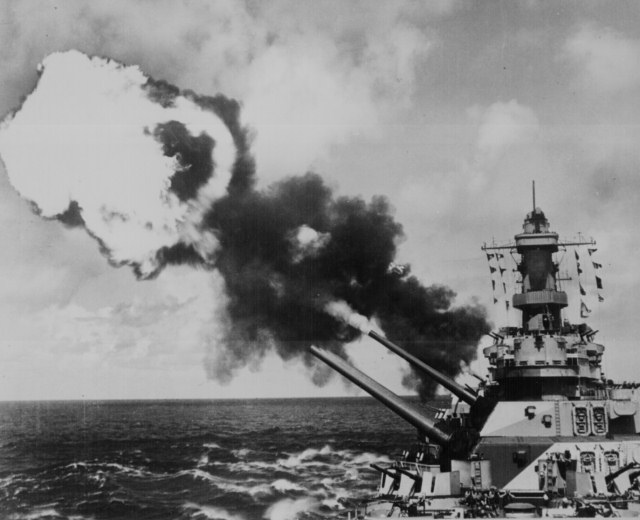
The General Board started work on the new battleship design in May–July 1935. Three design studies were submitted:
>”A”: 32,150 long tons (32,670 t), nine 14-inch (356 mm) guns (3×3) all forward, 30–knots, 14-in armor
>”B”: 36,000 long tons (37,000 t), 30.5 knots 14 in prot. 12x 14-inch guns (3×3)
>”C”: 36,000 long tons (37,000 t), 30.5 knots 8x 16-inch/45-caliber (4×2)
The Bureau of Ordnance later make known as new “super-heavy” 16-inch shell. Therefore all three designs evolved, renamed “A1”, “B1” and “C1”. However “A1” was now only 500 long tons below the 35,000-ton limit and the two other about 40,000 long tons.
Named fast battleships by the General Board, their speed was not fixed and could be lowered if needed. The Naval War College, consulted suggested a more reasonable top speed of 23-knot. Therefore, five more design studies were produced taking in account these lower speeds (and therefore smaller machinery) until September 1935. Speed oscillated between 23 and 30.5 knots, while main armament was comprised within eight and nine 14 inch or 16-inch guns. Standard displacement also oscillated between 32,000 and 41,100 t.
The “D” and “E” designs were true ‘fast battleships’ again, with a main 16-inch battery, while Design “F” was a radical attempt at a hybrid battleship-aircraft carrier, a la Furious, with three catapults mounted on the forward deck and eight 14-inch guns aft, in two quadruple turrets. This radical approach was reportedly favoured by President Franklin Delano Roosevelt, but since the future aircraft launched from these catapults were necessarily inferior to land-based aircraft as they used floats to be retrieved at sea, airmen argued this was a poor solution.
Nothing came of the design. Designs “G” and “H” however return to the slower 23-knot standard, and still armed with nine 14-inch guns in triple turrets. The “H” seemed at the time a very well balanced design by the Bureau of Construction and Repair. But the General Board leaned in the end towards the faster types designs.
With a displacement of 35,000 tons, two choices emerged eventually, a kind of “A1” design but faster at 30 knots, more lightly armed and armored, or a slower design armed with heavier guns and probably not a sufficient protection against 16-in shells. Five more studies were presented in October with 14-inch guns, 30-30.5 knots. Both had four turrets but mounted less armor. The “K,” design still had a 15-inch (380 mm) belt, 5.25-inch (133 mm) deck and a 17–27 km immune zone against 14-inch shell. It was liked by naval constructors, respected the 35,000 tons limit without any margin. “L” and “M” to save weight used quadruple turrets like French designs (Dunkerque) but with three turrets, so 12 guns.
Officer clubs of the USN which discussed the design informally voiced construction of battlecruisers for carrier escorts, also to oppose the IJN Kongō class. Admiral William Standley, and also the president of the Naval War College Admiral William S. Pye, both respected figures, plus senior officers and line officers engaged in strategic planning also approved this, although a few argued that an aerial attack could be a solution also against the Kongōs. The General Board selected eventually settled on the “K” design as a base for further developments, of which resulted the North Carolina class battleships. In the next part of this study we will focus on other aspects of USN Battleship designs.
USN ww2 battleships particulars
Outside the fact the USN wartime capital ship fleet was split between WW1 era dreadnoughts and fast battleships of the new generation, they eventually were all armed and equipped the same way. Outside their main and secondary armament in wartime, USN Battleships adopted the same AA artillery, made of Bofors and Oerlikon guns. Ironically, both were foreign designs: Bofors was Swedish and Oerlikon was Swiss. But they formed the best possible AA cover at the time against low-flying 500 kph piston aircraft, while the ubiquitous 5-in dual purpose turret made a sensible intermediary long range AA cover. The subject would not be complete without a word on onboard aircraft and radars.
Armament
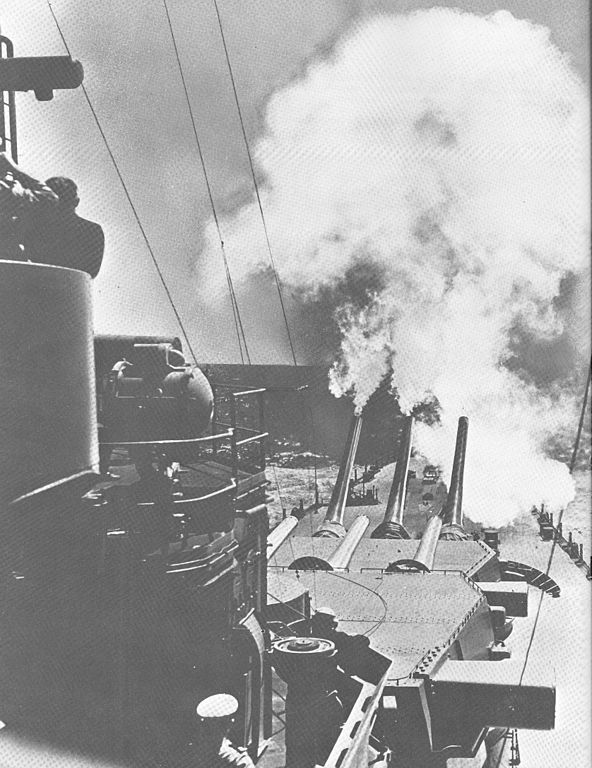
USS North Carolina fires over bow
Main armament
Fortunately in 1941, the USN no longer had the first generation battleships in service, those armed with 12-in guns (305 mm), but the Wyoming class. The bulk of the fleet was made of “standard” super-dreadnoughts armed with a 14-in battery, which simplified supply. The interwar generation swapped on the new “super-heavy” 16-in shell (406 mm), which was still the norm until 1945. Larger 18-in calibers once were planned but cut short by the Washington treaty and never again put on the table. The only difference was a rise in targeting precision and range, better propellant, longer barrels, which improved accuracy and lethality on the last generation, the Iowa class.
-12-in guns (305 mm): Only used by the Wyoming class (twin)
-14-in guns (356 mm): Used on the New York (twin), Nevada (twin-triple), Pennsylvania (triple), New Mexico (triple) and Tennessee classes (triple).
-16-in guns (406 mm): Used on the Colorado (twin turrets), North Carolina, South Dakota, and Iowa class (triple)
Secondary armament:
Thanks to the sense of standardization within the USN the choice was made soon to settle on a unique caliber, slightly less powerful than the 6 in (150 mm) used by the Royal Navy, German Navy and IJN among others, but faster and with more manageable rounds. This was the 5-in (127 mm) caliber. At first it was used in casemates along the hull and later in the deck superstructure to avoid wetness. Called 5″/51 caliber gun they had a long career in the USN, first as protected guns under casemates or in open air mounts, without shielding on decks. Variants comprised the Marks 7, 8, 9, 14, 15 and they were also used as dual-purpose guns in tailored mounts, for long range AA, also equipping many USN Carriers, submarines, cutters, and all USN Battleships until the new South Dakota class. The British had their own equivalent, the BL 4.7-inch 45-calibre naval gun and the IJN the 12 cm/45 3rd Year type.
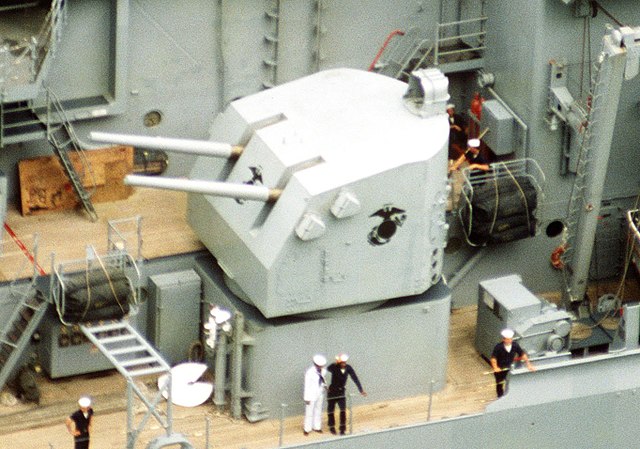
Typical twin 5in 38 onboard uss new jersey.
At the end of the interwar, work started on a new twin 5 in (127 mm) DP gun turret. The same gun called 5″/38 caliber gun was also widespread on USN destroyers, either in open and masked mounts or in enclose mounts and semi-automatic loading on the new Fletcher class DDs. Normal rate of fire was 15 rounds per minute and per barrel up to 22 rounds per minute for short periods with a well trained crew. The twin mount was called Mk22, followed by the Mk28 and Mk32, to the Mk38 inaugurated by the AA cruisers of the Atlanta class.
AA armament:
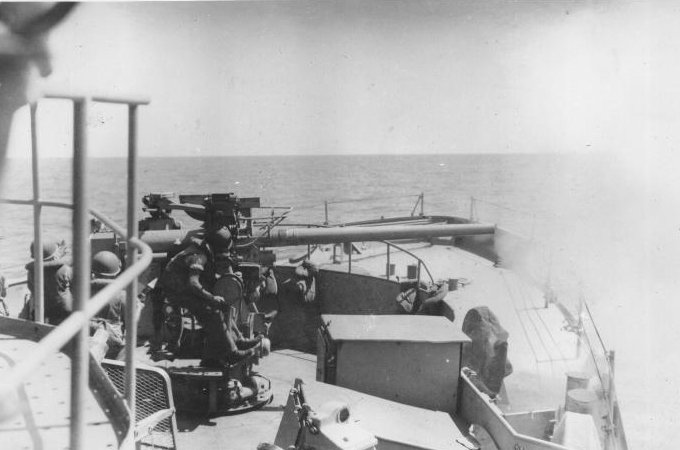
3-in gun onboard USS Pivot. This was the standard, slow but long range “FLAK” USN gun during wartime.
At some point, six calibers existed until the choice settled on two main calibers in wartime: The Bofors and Oerlikon; A larger, third type also widespread was the old 3-in (76 mm) with longer range but slower rate of fire which survived under modernized versions and twin mounts in the Vietnam war. The smaller calibers were the “Chicago Piano”, a rare quad-1.1″/75 caliber gun (28 mm) only used on a handful of ships, the single or twin 0.5 in (12.7 mm) Browning M1920 heavy machine gun also adored by the Army and Air force, and the small Browning liquid-cooled 0.3 in (7.5 mm) M1919. At the time of the Pearl Harbor attack, the USN staff were still uncertain of the caliber to choose against rapidly-improving and faster planes, and there were 3-in guns and much lighter M1919 MGs with nothing in between. Needless to say, the 3-in were only marginally effective against bombers flying in formation at medium altitude, but useless against dive bombers or fast low-flying planes, while the smaller caliber lacked hard-hitting power.
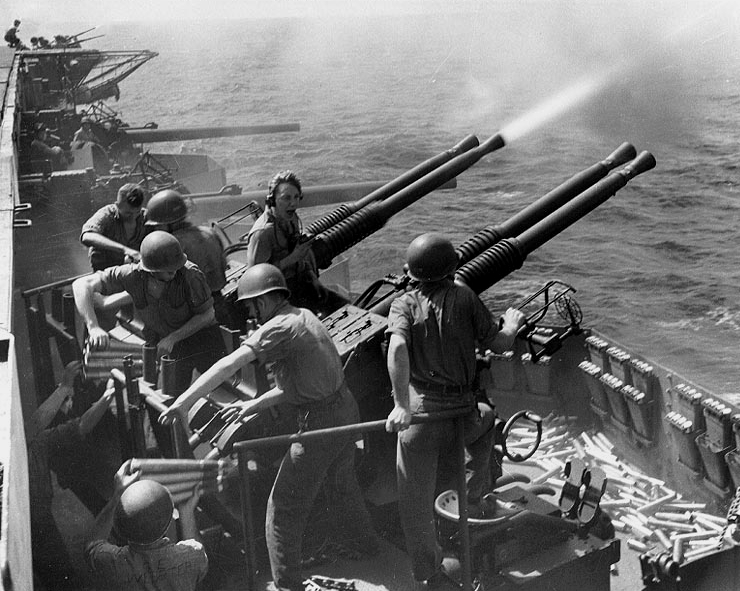
The Bofors 40 mm is arguably celebrated as the “best naval AA gun of WW2”. For AA guns in general, the Rheinmetall 88 mm is a serious contenter. Onboard USN battleships the “quad” was somewhat “labor-intensive” with a crew of 5 including a traverse operator, elevation operator, two loaders and the pointer/gun battery commander. In comparison the British “Pom-Pom” were octuple befors occupying a surface slighlty superior while requiring even personal (up to 8 in some photos) despite the latter was automatic. But it also had a lower velocity. So overall the US system was better.
Both the Oerlikon and Bofors would fill this gap, both in terms of rate of fire and hitting power. The first was much better than the 0.5 in MG while the second provided the required “volume of fire” although still crew-intensive. The Bofors were licence-built and existed in heavy open mounts with five servant, loaded by clips, in two sets of twin mounts. The first sets arrived in the US from Scandinavia, along with evacuated personal on 28 August 1940 aboard the Army transport USAT American Legion, along with a twin-mount air-cooled example, spare parts and 3,000 rounds of ammunition directly from Bofors, an order from the bureau of ordnance. The USN from this, developed its own version, water-cooled. It was still active in some ships in the 1970s.
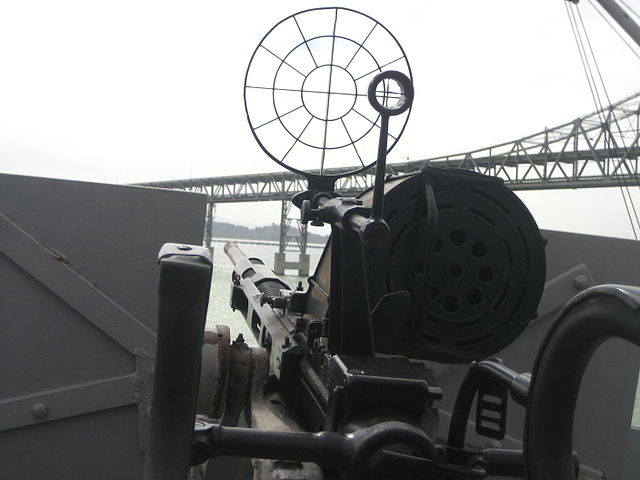
The 20 mm Oerlikon story is a little bit different, its development was German and dated back from WW1 to be used onboard aircraft of the Luftstreitkräfte and as AA guns. Due to Versailles treaty restrictions the design was developed in neutral Switzerland, at Oerlikon near Zürich from 1925. The Oerlikon SS in 1938 became the basis for the USN licenced version, culminating with the 650 rpm capable 2SS in 1945. This was basically a scaled-up machine gun, which procured several advantages: It was air-cooled, required only one man as the loading called for an ammo drum with a loading going from one mount for another, provided protection for the operator with a shield, simple targeting and pointing.
[su_spoiler title=”More on USN shipborne AA during WW2″ open=”no” style=”default” icon=”plus” anchor=”” class=””]
[spoiler]
At the start of the Pacific War, barrage tactics were used, trying to fill a volum in which the target was supposed to fly through, hoping to hit it. This tactic was a bit more effective than the IJN. Indeed atMidway, IJN AA fire downed at least five American planes. The two navies had different philosophiesfor the protection of their carriers too. The US Navy emphasised maneuver, as well as the whole defensive ring of escorts for supporting fire.
USN AA guns were well served between the hard-hitting 5″/38cal dual-purpose and well completed by the 40mm Bofors and 20mm Oerlikon guns in single and twin mounts. On the IJN, individual, radical manoeuvers were preferred to avoid attacks. Standard AAA was in general less effective and served by a lousy fire control. Ofter stuck between the old 4.7″ gun and 25mm gun as a close-in weapon, lacking hitting power.
Radar control became the norm for the 5″/38cal mounts, starting with the Atlanta-class light cruiser, indispensable to serve her eight twin turrets. Their fire therefore was not only hard-hitting but more accurate and culminated on the the Iowa-class battleship, with 10 twin turrets. In 1945, it began to become suicidal to attack a USN task force, hence, compounded with the lack of good pilots, the choice of Kamikaze tactics. Indeed they soon calculated that 12 hits could be obtained using conventional attack methods, for 300 planes in the sky, and 220 lost, whereas with kamikaze, 60 planes were needed for the same score. At that time, there was no shortage of always younger inexperienced volunteers.
One of the most effective innovation going with the 127 mm (5 in) turret was the adoption of the “VT” or proximity fuze. This was a micro-radar unit mounted in the shell nose to explode when coming close to an airplane. When set for the correct altitude it could cause some damage, buy the USN still found statistically that it required about about a thousand 5″ rounds to shoot down a plane using traditional shells but 250 using VT shells. These could be delivered between 15 and 20 rounds/minute. Making the Atlanta-class capable of filling the sky every minute with 250 rounds at eight miles. The Japanese on their side were desperate to find a solution, using many 25 mm weapons, trying rockets and even developed AA rounds for their battleship’s main guns. A good example of this was the Yamato firing with her main 460 mm guns on approaching USN planes in 1945, creating giant shrapnell clouds.
Every attack on a naval vessel, US or Japanese, by aircraft ran a risk of being knocked down by anti-aircraft. Even at the very end, US planes were being shot down by AAA fire. It was just more likely to happen to a Japanese plane attacking an American ship than the other way around.
[/spoiler]
[/su_spoiler]
Onboard aircraft
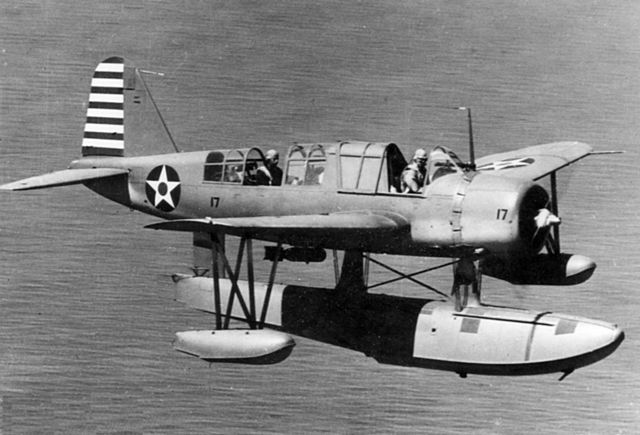
It should seems surprising that USN Battleships still combined radars and planes by 1945. This was because both were complementary. Indeed, until the radar became practical in 1942, observation (especially long range) rested on multi-engine seaplanes such as the Consolidated Catalina and Grumann Mars, and around the fleet, by floatplane launched by catapults which provided more than radars of the time: Reconnaissance of the objective and longer range. They can also perform casual ASW missions and bombing/strafing, or recovering downed airmen, carrying dispatched and personel.
However they mostly served to direct gunnery fire at long range, but were slow and ill-equipped in case of interception by enemy fighters. The most disastrous was Curtis S03C Seamew which appeared in 1942 but was retired in 1943. There was a case at Iwo Jima of a Zero out-manoeuvred and and shot down by a Kingfisher and in Italy, some of these planes multiplied bombing and strafing attacks on Italian troops. They can also perform ASW patrols armed with two 325 pound depth bombs but no kill was ever registered. The idea stuck until the introduction of helicopters in the 1950s.
The most dependable was probably the interwar SOC seagull, in service long after the war and until 1945, such was its reliability. It was a biplane with the usual rear-seat observer/radio operator/gunner. The spacious wartime OS2U Kingfisher was probably a favorite, the most produced of these models with 1,519. The last generation was the Seahawk, by far the faster of USN seaplanes. The main reason was its design as a naval fighter, inspired by the IJN Nakajima A6M2-N “Rufe”. It can reach 313 mph with its 1,300 hp R-1230 engine and was armed by two 0.5 cal HMGs. But it was introduced late, in June 1945 and served until 1949. By then, the concept of seaplanes was all but obsolete.
Vought O2U Corsair (1926)
Vought FU (1927)
Naval Aircraft Factory N3N (1935) – Floatplane trainer
Curtiss SOC Seagull (1935) Standard USN Floatplane, replaced by the Curtiss SO3C Seamew from 1943.
Vought OS2U Kingfisher (1938) The proverbial USN seaplane, along side the Curtiss SOC seagull.
Curtiss SO3C Seamew (1942) Like previous ones, for observation, and carrying bombs and depht charges.
Curtiss SC Seahawk (1944) – arguably America’s best floatplane scout of World War II.
Electronics: Radars and computing
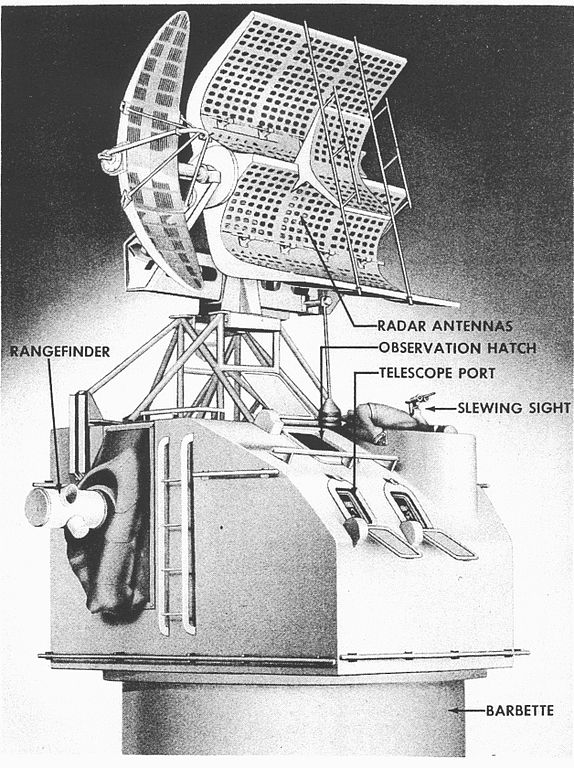
Mk37 Fire director circa 1944
Fire direction went a long way since the WW1 era Barr & Stout rangefinders. The director system of fire control was innvented by the British in 1912, allowing data to enter and be redistributed into target coordinates. As early as 1916 at Jutland, battleships used firing tables with calculation charts and chronometers to take in account the speed and distance if the targets, at first the pioneering Dreyer system, soon replaced by the Admiralty Fire Control Table. The couple fire control computer/plotting table was soon improved.
Unmeasured and uncontrollable ballistic factors were hard to take into account, so the British soon favored coincidence rangefinders while the USN preferred the stereoscopic type. The first rangekeeper was introduced on the USS Texas in 1916. In WW2 were introduced analog computers, servomechanisms (called “power drives” in the U.S. Navy), the Mk.1/1A models containing approx. 20 servomechanisms, position servos to minimize torque load on the computing mechanisms and cope with human operator fatigue.
The last step was the most important one: Pioneered in 1937-38, and slowly experimented on selected ships (like USS California and Pennsylvania at Pearl Harbor in Dec. 1941) they allowed ‘blindfire’ radar fire-control, long range gunnery by poor weather and at night, when opticals became inoperative. The US practice was soon to integrate Gyroscopic stable vertical elements, to keep a solution on target at all times. The radar baptism of fire was already demonstrated during the battle of Cape Matapan when three Zara class Italian cruisers were mowed down by British dreadnoughts, and conformed in the USN during the Naval Battle of Guadalcanal when the USS Washington destroyed the battleship Kirishima at night, combining optical and radar fire-control.
The cornerstone of USN electronics targeting was the Analogue Gun Fire Control Systems (GFCS), declined into the MK 33, 37 GFCS and Mark 37 Director. It was efficient when coupled with the Ford Mark 1A Fire Control Computer.
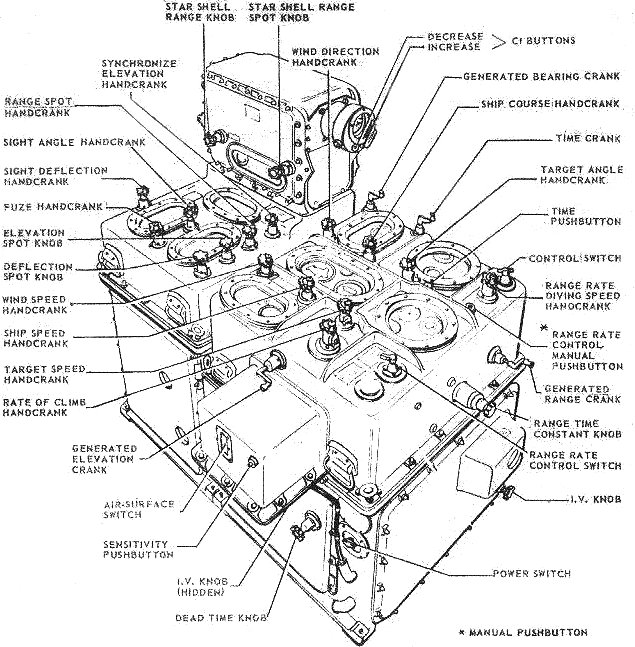
Ford Mark 1A Fire Control Computer Controls
The last battleships: The Montana class
There were three ‘what-if’ battleship classes within 20 years in USN history: The 1919-1920 South Dakota class and battlecruisers of the Lexington class, cancelled with the Washington treaty and already seen in the WW1 battleships article and on the other hand, the Montana class planned already by 1940, when the four Iowa were already provisioned. So these were “wartime” battleships, despite the fact the US were still not at war.
Carl Vinson was the chairman of the House Committee on Naval Affairs and father for the Vinson Naval Plan. His second phase planned in 1938 was signed by President Franklin D. Roosevelt, authorizing the four South Dakota-class fast battleships and one of the Iowa-class, but also provisioned Four additional battleships numbered BB-63-66, approved in 1940. The last two were the planned replacements for the Iowa, the first Montana class. By 1942, the US Navy high command needed them fast and instead BB-65 and BB-66 were allocated to two more Iowa-class battleships, the USS Illinois and Kentucky.
Meanwhile, large battleship design schemes has been discussed since 1938 to counter any new construction for the IJN, not knowing of the Yamato though. The latter indeed had refused to sign the Second London Naval Treaty and were obviously seeking a step above for their first post-wWashington ban design. Rumors were insistent about a 18 inches (457 mm) main battery and the 1938 London treaty “Escalator Clause” raised displacement to 45,000 long tons (46,000 t), allowing in the USN the future Iowa and Montana.
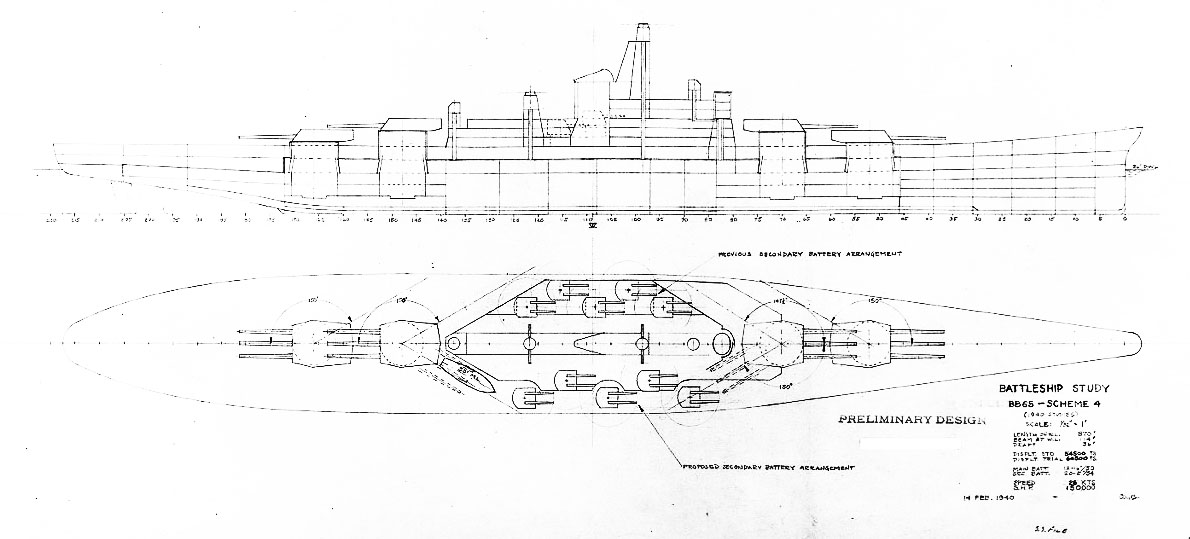
1940 preliminary study for BB-65, scheme 4.
Freed from this initial limit, the USN evaluated 45,000-ton battleship designs.
-“slow” (27-knot) schemes with better firepower and protection
-“fast” 33-knot schemes. The latter evolved into the Iowa class and the first “slow” designs were to be evolved into ships armed with twelve 16-inch (406 mm) guns, 60,500-ton. This was the initial requirement of the Montana class. The latter was approved by the United States Congress (Two-Ocean Navy Act 1940) and funding approved in 1941. As the last battleships ordered by the Navy, designation was BB-65-69and later BB-67-71 because of the supplementary Iowa-class ships.
The Montana class would have given, if delivered in 1944 as the Iowa, a grand total of 17 new battleships; A force able to deal with a combination of naval powers. These Montana class were also the only possible contenders for the new IJN Yamato and Musashi. Only the very ambitious German Kriegsmarine Z-plan battleships of the H-42/H-44 design would have been larger. The Montana class BBs were the “weaker” of all with a max caliber of 406 mm “only” but compensated with twelve guns versus nine of the Japanese and eight on the Germans.

Line drawing of the ships, if built (wikimedia commons).
The Montana class were to be around 63,200 tons standard, flirting with 72,000 tons fully loaded, with hulls 280 m long overall and 37 m wide. They were propelled by a set of eight Babcock & Wilcox 2-drum express type boilers, powering 4 sets of Westinghouse geared steam turbines for a total of 172,000 hp (128 MW). The Montana were able to reach 28 kn (32 mph; 52 km/h), less than the Iowa class but with greater range. Their master ace was a superior armour, with 16.1 inches (409 mm) belt, 18 inches (457 mm) transverse bulkheads, turret barbettes ranging from 21.3 inches (541 mm) down to 18 inches (457 mm) (aft), or turret faces of 22.5 inches (572 mm) plus decks between 57 and 180 mm. This was all superior to the main caliber and able to resist IJN expected 457 m shells at all angles, with an all-or-nothing scheme.
The main armament was design to overwhelm the enemy with twelve 16-inch (406 mm)/50 cal Mk 7 guns volleys, well served by radar control, while the AA was considerable dur to the ships lrge size, comprising initially 20 × 5-inch (127 mm)/54 cal on Mark 16 guns turrets, ten 40 × Bofors 40 mm anti-aircraft guns and 56 × Oerlikon 20 mm anti-aircraft cannons.
Eventually the design was ready in 1940, when the ships were ordered later and suspended indefinitely in 1942 (priority shifted towards aircraft carriers and maintaining the existing fleet and repairing the battleships sank) until being canceled on 21 July 1943.
And what about the Alaska class ?

The question can be asked indeed. These 1944 ships has been registered both by the USN admiralty and most authors since as “heavy cruisers”. But since their main battery is the same as the oldest deanoughts in service by the time they were launched, the question is valid whereas to consider them just as heavy cruisers or an attmpt to devise a new generation of ‘battlecruisers’, twenty years after the Saratoga class.
Indeed they were ordered before the war, six “large cruisers” (CB 1-6 USS Alaska, Guam, Hawaii, Philippines, Puerto Rico, Samoa). The term is important as it was never used before. The wartime Baltimore class and their successors, the Des Moines were indeed “heavy cruisers”. So some authors indeed tend to see them as second class battlecruisers (since their armament was substandard, it should have been 16-in, or 406 mm instead). Their genesis dated back a long way, from the time Germany revealed her Versailles-treaty compliant Deutschand class vessels, armed with six 28 cm guns. The design evolved as to now counter the very fast Scharnhorst-class ships.
Later it stayed justified as Japan was rumored to built a brand new class of battlecruisers. In the end, the design ended as a “cruiser-killer” of which only two ships were completed in late 1944, USS Guam and Alaska, used as bombardment ships and fast carrier escorts. Their main artillery was twice as fast as the old 14-in /50 of pre-treaty battleships, and way more accurate. However due to the fact that only two ships were completed, and innovations proper to the class, made them seen as “white elephants”, a costly experiment (or an admiralty caprice) for American taxpayers. Both were scrapped after 1961, seeing little service and a long reserve period. Hawaii was never completed, waiting for a postwar design conversion, first into a missile cruiser, second as a command ships, but they never materialized.
Sources/Read More
Robert Gardiner Conway’s all the world’s fighting ships
//en.wikipedia.org/wiki/Montana-class_battleship
//www.fr.naval-encyclopedia.com/2e-guerre-mondiale/us-navy-2egm.php#cuir
//www.usni.org/magazines/naval-history-magazine/1990/january/battleship-floatplanes
//www.pearlharboraviationmuseum.org/pearl-harbor-blog/u-s-scoutobservation-floatplanes-in-world-war-ii/
//en.wikipedia.org/wiki/Ship_gun_fire-control_system
Nomenclature of USN battleships
Wyoming class battleships (1911)
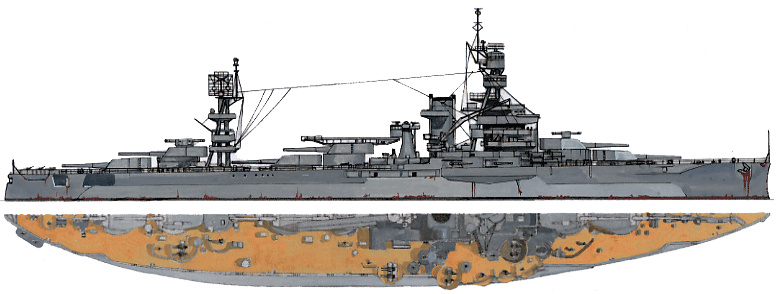
USS Arkansas – Authors illustration
USS Wyoming and USS Arkansas, both launched in 1911 and completed in 1912, were the oldest American dreadnoughts to participate in World War II, with the exception of Utah (from the earlier Florida class of 1910). But the latter had been reconverted into a target ship, partly without armor and entirely with artillery, in conformity with the Washington treaty’s tonnage limitations.
USS Utah was in Pearl Harbour at the second attack on December 7, 1941. The two Wyomings were also the only USN battleships from before the Great War to be operational during WW2. They had been preceded by the Florida, Delaware and South Carolina classes (1909). All retained the characteristics of the previous ships, but their size gave them the advantage of an additional turret. The caliber of their main artillery -305 mm – was unique among USN dreadnoughts, back to the early days and no longer relevant both in terms of range and impact force in 1941.
Against a Scharnhorst-class German battleship, much faster and equipped with advanced optics, they would probably have been hurt. However, the twelve 12-inches all axial allowed full broadside, not an argument to take lightly. Secondary armament was altered in 1927, with the removal of the casemate guns, replaced by “dual-purpose” 5-in/127 mm in single mountings, three on each side, and eight 3-in (76 mm) AA. From 1943, this armament was completed by an impressive anti-aircraft battery of 40 and 20 mm.
In fact, with a modernization in 1925-27 and an overhaul for the USS Arkansas in 1938, the old veterans were still valiant in 1941. USS Wyoming had moved to the reserve in 1931, and served as a training ship for the fleet’s gunners. USS Arkansas remained front line, assigned to the Atlantic fleet, and performed as an escort at the beginning of the war. So both were not in Pearl harbour. Arkansas was rearmed in New York with a particularly powerful AA, participating in the landings in Normandy (Overlord) and that of Provence (Anvil). They were then sent into the Pacific, covering the operations of Iwo Jima and Okinawa. Set aside in August 1945, USS Arkansas ended her days blasted in the Bikini nuclear test (Operation Crossroad) but Wyoming was kept as TS and scrapped in 1947.
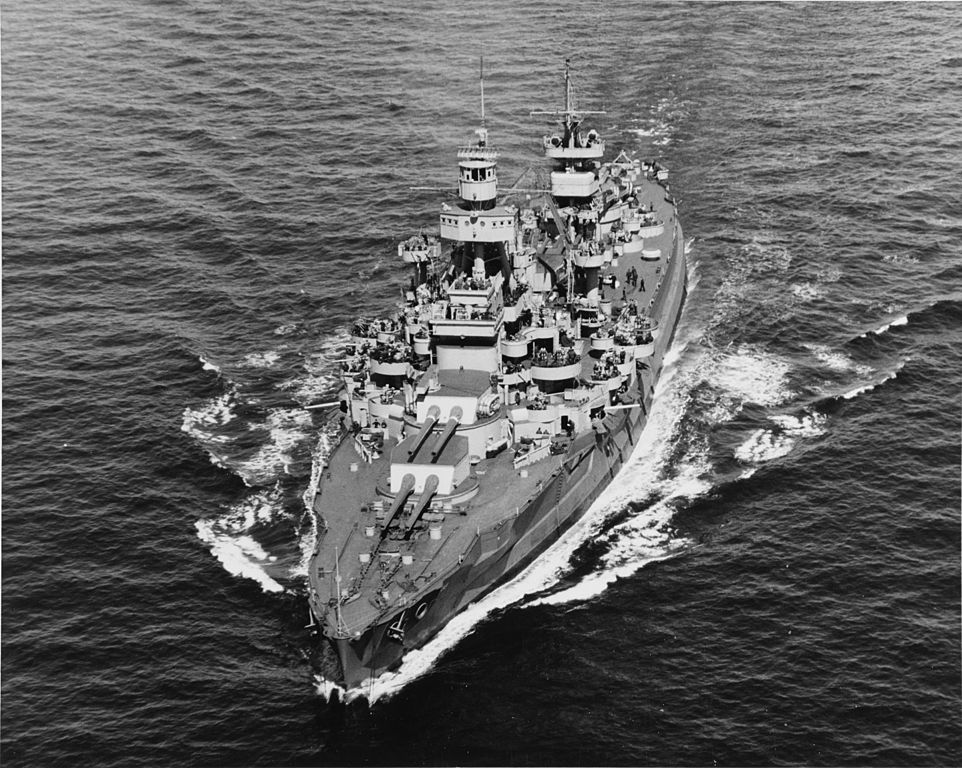
Characteristics (1943):
Displacement: 26 066 t, 31 000 T FL
Dimensions: 172 x 32,30 x 9,70 m
Propulsion: 4 shaft turbines Parsons, 4 Babcock et Wilcox boilers, 28 000 hp. 20,5 knots
Armour: Belt 279, bulkheads 38, decks 51-76, turrets 305, blockhaus 305 mm.
Armament: 12 x 305 mm, 6 x 127 mm, 10 x 76 mm, 9 x 4 x 40 mm, 26 x 20 mm Oerlikon AA.
Crew: 1650
New York class battleships (1913)

Author’s illu of the USS New York.
These two battleships followed the Arkansas with the next 14 in (355 mm) instead of the 12-in (305 mm), allowing for 5 twin turrets, still in the axis, although this central turret was not between two funnels of the central massif, as on French, Japanese, British or Italian Ships, but at the rear, in front of the superfiring ‘X’ aft turret. The USS New York and the USS Texas were the last battleships completed before the Great War. They were larger and heavier and kept the Arkansas flush-deck hull.
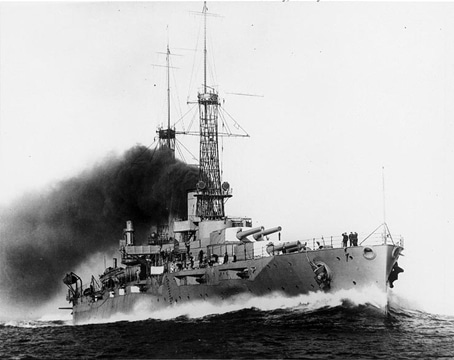
USS New York in trials, 1915
Completed in 1914 (March-April), they served with Wing 6 Atlantic Sqn. In 1916, USS Texas was the first ship of the US Navy to receive anti-aircraft guns, in this case 3in (76 mm) pieces mounted on the deckhouse. In 1918, USS Texas, inspired by British trials, received an aircraft platform on her front turret, but did not set up the first aircraft tests until 1919, off Cuba. USS New York, for her part, intervened in Vera Cruz (1914) with a marine company.
In 1925-27, both went back to the shipyard for a large refit, with a series of transformations, the first of which concerned their new boilers, coming from the cancelled Lexington class battlecruisers of 1923. The main consequence was the passage of coal to oil, with a gain of place and range. Their machinery originally triple-expansion vertical steam systems lacked power and caused excessive vibration, to the point of threatening their propeller shafts.
ASW protection was greatly improved, decks receiving a significant extra shielding (more than 90 mm), as well as ammunition stores. For the rest, their main armor remained unchanged, but later massive side bulges and internal ballasts (2 meters each wide) were added. They also received 3in AA guns, 16 in all, on their main deckhouse, expanded. Finally, new rangefinders were mounted, and a catapult requiring the removal of the mainmast and replacement by a more modest tripod structure. During a second phase , their front mast was removed also, replaced by a new tripod, while the bridge superstructure was completely rebuilt, with new telemeters and gunnery computer.
In 1942, both units served in the Atlantic. A new modernization began and they were cleared of their battery and hull casemate guns, retaining only six 5-in in the battery deck, and in addition received a radar and 10 quadruple 40 mm AA, plus 44 dingle 20 m AA. Both units continued to serve in the Atlantic until the end of the war. USS Texas was preserved as a memorial in 1948 and is currently being visited, and New York was disarmed and finally used in a nuclear test and sunk in 1948. It is interesting to note the oldest USN battleships were kept for the Atlantic, while the newest and most numerous classes served in the Pacific, such was the threat posed by the IJN.
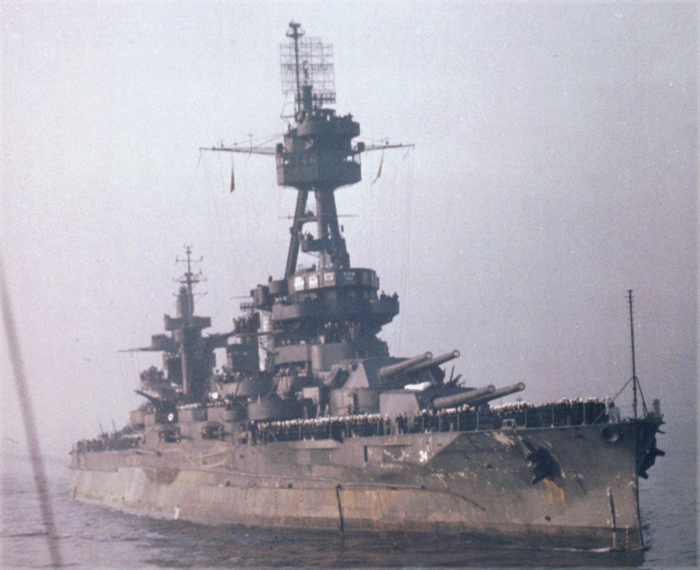
USS New York in 1945 navy day celebration (color photo, cropped)
Characteristics (in 1943):
Displacement 27,000 t. standard -32,000 t. Full Load
Dimensions 174.65 m long, 32.30 m wide, 9.19 m draft
Machinery 4 shaft Parsons turbines, 4 Babcock and Wilcox boilers, 28,000 hp.
Top speed 21 knots
Armor Belt 280, Battery 280, Barbets 280, turrets 305, blockhouse 292mm
Armament 10 guns of 355, 6 guns of 127, 8 of 76, 40 of 40 and 44 of 20 mm AA
Crew 1,290
Nevada class battleships (1914)
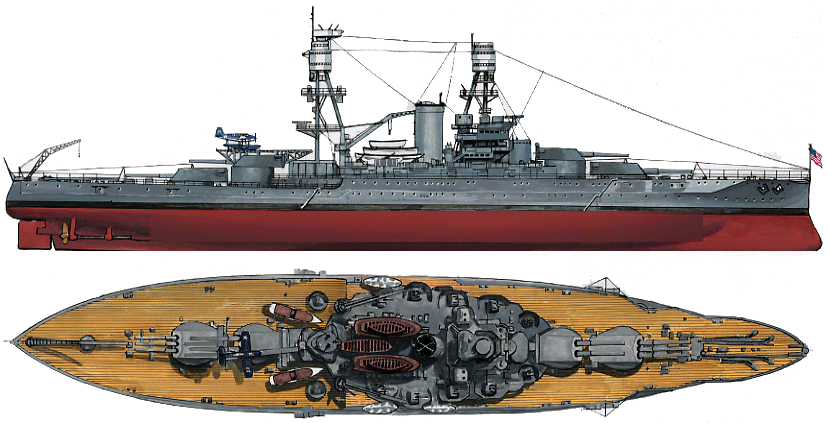
Author’s illu of USS Oklahoma in December 1941. She had just received Vought Kingfisher for observation.
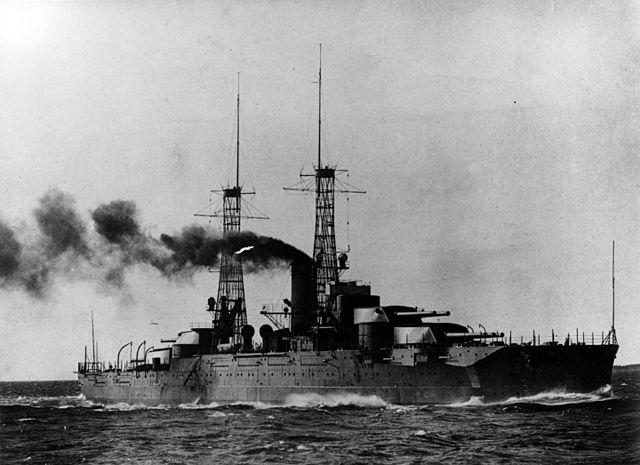
USS Nevada in 1916, to compare the magnitude of the reconstructions.
The battleship USS Nevada and her twin, USS Oklahoma, were two rather different ships from the previous Texas, as they inaugurated triple turrets, sacrificing the central turret to distribute these forward and aft in four spots instead of five. In total, these were ten 14-in guns (356 mm). They were criticized for the insufficient artillery increase and the lack of protection against torpedoes. In 1928, both units were sent in dry dock for transformation and modernization. They received, like the USS Wyoming and Texas, tripod masts to support the weight of their new firing systems.
Their casemate pieces were removed, and new 5-in AA in single mounts were installed on their battery deck. Nevada received turbines from the cancelled USS North Dakota battleship. They also received catapults and seaplanes, and some batteries of 0.5 in AA HMGs (12.7 mm machine guns). It was planned to install a radar in January.
On December 7, 1941, they were badly damaged during the Japanese attack. While Nevada survived extensive damage, sunk straight and later refloated, USS Oklahoma exploded and was shattered. She was considered a terminal constructive loss. That was, with Utah the only ‘dry loss’ due to this attack. A new overhaul took place for the surviving USS Nevada, which emerged in 1943 with a significantly different look: The rear tripod mast was removed in favor of a new tower bridge, boats stacked behind the funnels, served by neck goose cranes, and the overhauled battery deck.
A larger battery superstructure was equipped with twin 5-in standard DP turrets (127 mm), and numerous 40 and 20 mm in single and quadruple carriages. In 1944-45, this culminated to 10 quadruple and 45 single 20 mm mounts, including 20 twin mounts. She took an active part in all pre-landing coastal bombardments in the pacific within her Task Force before retiring in 1948.
Characteristics (in 1943):
Displacement: 29,000 t. standard -32,000 t. Full Load
Dimensions: 177.5 m long, 33 m wide, 9 m draft
Machinery: 2 shaft Parsons turbines, 6 Express Office boilers, 25,000 hp.
Top speed: 20.5 knots
Armour: Increase bridge protection 44-50 mm
Armament: 10 x 356 (2 × 2, 2 × 3), 16 x 127 mm (8 × 2), 8 x 40 mm (4x 4), 28 x 20 mm AA
Crew: 1,374
Pennsylvania class battleships (1916)

Pennsylvania and Arizona were two dreadnoughts scheduled for 1913, which were an improvement on the previous Nevada with only triple turrets instead of two twin and two triples, giving them a total of twelve instead of ten. As before, they also carried 22 5-in guns in casemates, four 3-in AA guns and two 21-in broadside submarine torpedo tubes. Their ASW protection had been remarkably improved compared to the previous class, the threat being taken seriously now. They were laid down in 1913-14, launched in March and June 1915 and completed in June and November 1916.
They were fully operational in 1917, when the US entered the war. USS Pennsylvania became flagship of the American fleet of the Atlantic until the end of the war. She escorted the liner that brought President Wilson to France for the Versailles conference in December. USS Arizona was part of the 6th Squadron in 1918, and landed marines to protect the US Consulate in Constantinople on May 14, 1919 at the time of the Greek occupation. Pennsylvania intervened in Costa Rica on August 18, 1921 landing a contingent of 400 marines at the border.
The two ships underwent a small overhaul in 1919-21, with the removal of their 5-in guns from the hull casemates, keeping those of the Central deckhouse, the addition of 2 new guns on it and corbel masts, and the addition of four 3-in (76 mm) AA guns on the battery deckhouse roof. They were also equipped with a small platform on the superfiring ‘B’ turret to launch an aircraft while the two others received rangefinders.
They were taken over in 1930 for a radical reconstruction. In particular, they received the new turbine from the North Dakota-class which as been cancelled, their corbel masts replaced by high tripod masts, and they had a rebuilt superstructure, 12-in and 5-in guns greatly improved, a new battery and a catapult on ‘X’ turret aft, with no goose neck. Their 12 boilers were replaced by more modern ones, oil-firing, saving space used for extra oil reserves and ASW protection.
Counter-keels were also added to the hull to improve stability and their two original submerged torpedo tubes were eliminated. They received 8 new 3-in guns (76 mm) AA and twelve heavy machine guns 0.5 in Browning in twin mounts. It was in this state that both were in Pearl Harbor when the Japanese attacked. USS Arizona received a bomb in the ammunition bay and exploded, capsized and became a total constructive loss. She continued to fill for more than two days, gradually drowning all her compartments, chasing the unfortunate survivors prisoner of their enormous steel coffin. Teams tried to free them out by attacking the thick hull with jack-hammer and dynamite, to little effect. The hill still lies there in the bay, now a memorial: A new construction was installed for this purpose and a jetty. This is also in part a memorial to all victims of the attack.
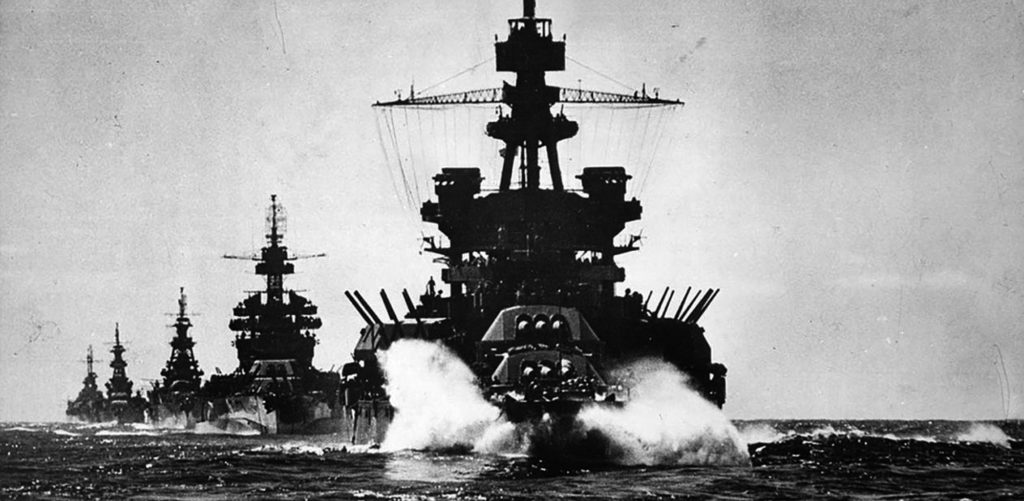
USS Pennsylvania in 1944, before the battle of Surigao.
USS Pennsylvania was in dry dock in the battleship row and was also severely hit by bombs. But she was later found to be recoverable whereas her condition required four months of labor. It was then completely rebuilt and modernized, from October 1942 to February 1943. Some of its portholes were plugged, superstructures and bridges rebuilt, new rangefinders and radar added, all casemates eliminated and replaced by height twin 5-in turrets, complete with eleven quadruple 40 mm Bofors and fifty single 20 mm Oerlikon AA guns. Finally, the rear turret catapult was removed as well as the goose neck cranes, the new catapult was installed at the stern, while the aft tripod mast was removed and replaced by simple pole to support a radar.
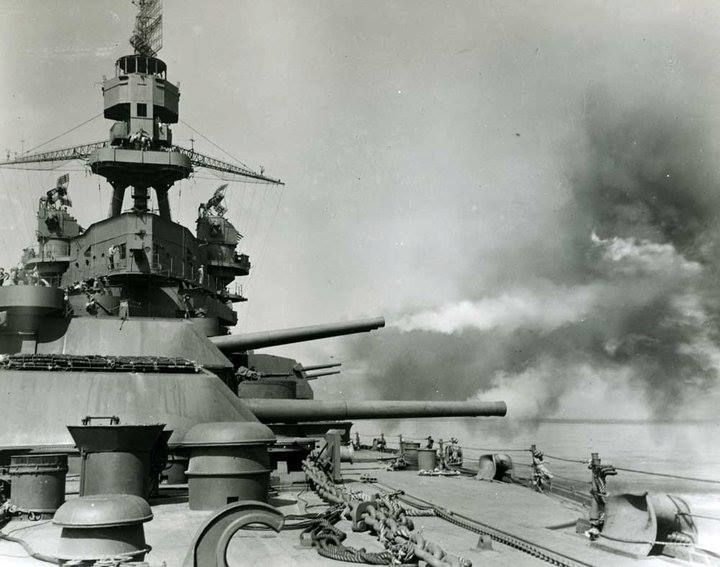
USS Pennsylvania firing
Returned to service, USS Pennsylvania participated in all of the US Navy’s major engagements, in Saipan, Guam, Leyte as part of admiral Oldendorf battlefleet, before returning to Puget Sound, New York. After a new and short refit in March-July 1945 she returned to operations on the Japanese coast in August 1945. She was hit by torpedo planes and Kamikazes on the 12th. She then returned to the USA for repairs, learning en route the capitulation of Japan. Summarily repaired, Pennsylvanian was converted into a test target to be send to the Bikini Atoll. She survived the first and second nuclear explosions, and was then used as a target ship for bombers. The last of these exercises took place on February 10, 1948.
Characteristics (in 1943):
Displacement: 33,400 t. standard -35,930 t. Full Load
Dimensions: 185.3 m long, 32.4 m wide, 9.20 m draft
Machines: 4 shaft Curtis turbines, 6 Express Office boilers, 33,375 hp.
Top speed: 21 knots
Armor: From 356 mm (belt) to 406 mm blockhouse and 457 mm turrets – increase bridge protection 44-50 mm
Armament: 12 x 356 (4 × 3), 16 x 127 mm (8 × 2), 44 x 40 mm (11×4), 50 x 20 mm AA, 3 seaplanes
Crew: 2,290
New Mexico class battleships (1917)

Author’s illustration in 1944
These three ships were ordered before WW1 but launched when the USA were at war with Germany. The New Mexico class (BB 40) included also the Mississippi and Idaho. They were completed at the end of 1918. Originally displacing 32,000 tons, they differed from the previous Pennsylvania by their more modern clipper bow, abandoning the classic spur in favour of more marine and functional forms. Like the latter, however, they were given twelve 14-in guns in four triple turrets. The secondary battery used 5-in guns in deck casemates, with some in hull sponsons. Their American silhouette was recognizable by their typical corbel cage masts.
After the arrival of the “big five” in the early 1920s, they were stationed for their entire peacetime interwar career in the Atlantic. From 1931 onwards, they were radically reconstructed, in fact more than all other American battleships: Their old powerplant was removed and replaced by modern tailor-built turbines, top speed reaching 22 knots, despite the increase in weight. Their frail masts were replaced by a tower bridge while another was placed at the rear. Hull casemate secondary guns were removed and the accesses welded shut. 8 more were added on the deckhouse in dual-purpose and anti-aircraft mounts. Systematic lighting and air conditioning allowed to eliminate most of the portholes as well. Rangefinders were also brand new, as the plotting table and ballistic computer. The three ships were recommissioned in 1934.
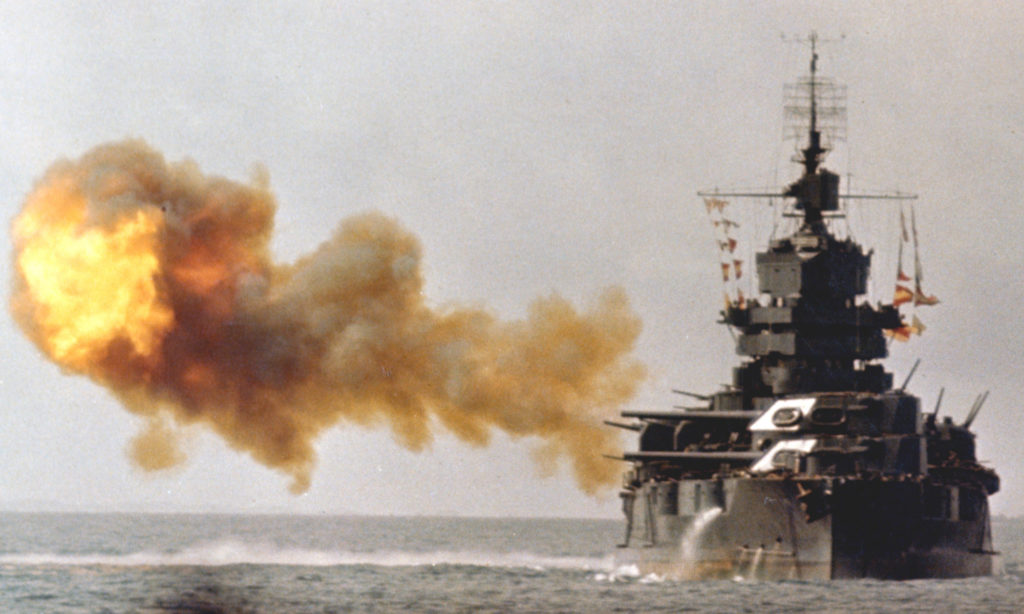
In September 1941, they took part in Atlantic squadron exercises. In 1942, they were sent in emergency to replace losses of Pearl Harbor , receiving a radar. In fact, apart from the new fast battleships USS Washington and North Carolina, they were the most modern battleships of the US Navy. They did not suffer any really serious damage in operations, the Mississippi being however damaged in 1944 by a Kamikaze. At the end of the war, they carried as standard 10 quadruple 40 mm carriages and 40 to 46 Oerlikon 20 mm cannons. They will be withdrawn from service in 1948, with the Mississippi serving as a target ship for the Atomic Atomic Bikini test, before being dismantled in 1956.
Read More about the New Mexico class Battleships
Characteristics (in 1944):
Displacement: 34,420 t. standard -36 160 t. Full Load
Dimensions: 190.19 m long, 32.40 m wide, 9.44 m draft
Machinery: 4 shaft Westinghouse turbines, 4 Express boilers, 40,000 hp.
Top speed: 22 knots
Armour: Belt 350, turrets 400, bridges 152, inner casemate 287-400 mm, blockhouse 400
Armament: 12 x 356 (4 × 3), 14 x 127, 24 x 40 (6 × 4), 16 x 20 mm AA, 3 planes
Crew: 443
Tennessee class battleships (1919)

The USS California battleship at Pearl Harbor in December 1941. He was the first to receive a radar, and the latter, in the test phase was disconnected this fatal Sunday – old author’s illustration
The battleship USS California and her twin USS Tennessee, were completed far too late to participate in the Great War but too early also to have been cancelled by the Washington Treaty. They were the last dreadnoughts built with the Japanese Nagato. Larger and faster than the previous New Mexico, they kept their four triple turrets configuration. They received very few changes during the 1930s, except for a new 5-in AA artillery in single dual purpose mounts on the battery deck.
They also kept their secondary casemated 5-in guns and the AA was reinforced with the first 20 mm and 0.5 in Browning HMG M1920 in twin mounts. This was a mere overhaul, not a total modernization, especially because of the lack of funds during the Great Depression. They were also often solicited and therefore unavailable. California and Tennessee served at Pearl Harbor in the Pacific Fleet.
In December 7, 1941, both received bombs and torpedoes. USS California sank, but fortunately without capsizing. Severely damaged she was conducted in drydock for repairs, as well as USS Tennessee, the least damaged of the “Big Five” (California, Maryland). Repairs turned into total reconstruction for modernization, and Tennessee, because of her good general condition, she served as a prototype for others.
Her redesign was based on the Nevada. She received a new superstructure with new radars and rangefinders, a completely revised weaponry with standard 5-in twin turrets, and an impressive AA artillery (10 quadruple 40 mm Bofors and 43 single 20 mm Oerlikon guns). Later ballasts were added and armor was reinforced on the sensitive parts. USS California followed the same path, and emerged in 1943 with a radically different silhouette.
Her AA armament was reinforced with four 40 mm quadruple Bofors and and twenty single 20 mm mounts. They both worked in Task Forces, mainly used for artillery support during combined amphibious operations and retired from service in 1959 and 1960.
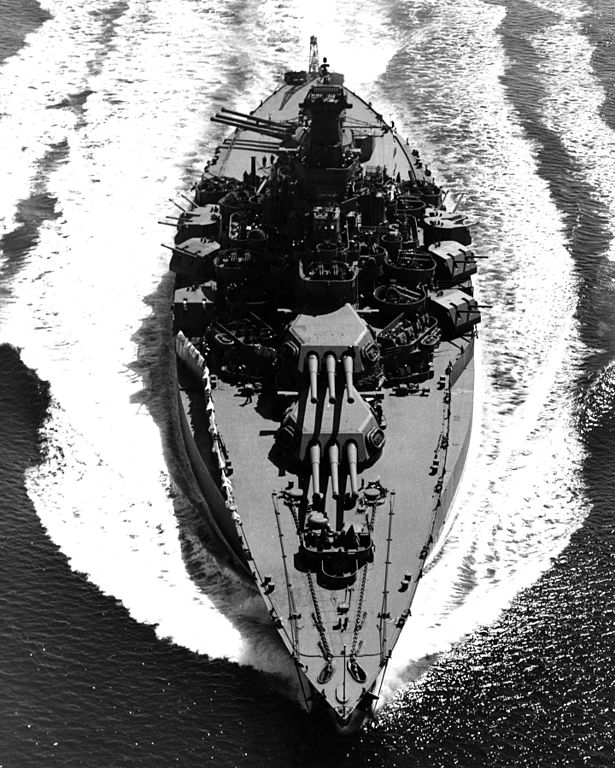
USS Tennessee (BB-43) after reconstruction underway in 1944
Characteristics (in 1944):
Displacement: 23,250 t. standard -29 240 t. Full Load
Dimensions: 114.7 m long, 12.1 m wide, 4.2 m draft
Machinery: 2 shaft 2 GE turbines, 4 Babcock & Wilcox boilers, 60,000 hp.
Top speed: 38 knots
Armor: belt
Armament:
Crew: 273
Colorado class battleships (1920)

The battleship USS Maryland in 1943 – Author’s illustration

USS West Virginia in 1944.
Constructed at the peak of the “battleship race” in 1919-20, these four ships not only shifted to the 16-in caliber (406 mm), but they were the first of a serie of more radical ships intended to carry eight 18-in guns, displacing from 45,000 to 60,000 tons FL. The Washington treaty put an end to this escalation. Under the treaty terms, the following six South Dakota-class ships were eventually cancelled and their hull broken up.
Nevertheless, the four Maryland (with Colorado, Washington and West Virginia), were too advanced to suffer the same fate: Started in 1917 (Maryland), 1919 (Colorado and Washington) and 1920 (West Virginia), they were launched in 1920-21. They were completed when the treaty was signed, February 8, 1922, Maryland is being tested, the other two will be completed in 1923. Finally, for tonnage reasons, USS Washington, the least advanced, was cancelled and her hull used as a target. She sank as such on November 25, 1924.
The remaining three units were no less remarkable. With their 16-in guns, they anticipated by their specifications the German battlecruisers and battleships planned with 380 mm main guns, and the Japanese which shifted to the 16-in with their Nagato in 1919. Ordered urgently and their hulls were, including for protection, a copy of California and New Mexico, their other details of superstructure and machinery being identical to those of California, namely electric generators which offered the advantage of a level of vibration equivalent to zero, and 8 boilers instead of 12. They also did not have casemate guns, but placed on the battery deck, fourteen 5-in guns (127 mm), and a complement placed on the roof of the deckhouse. Tey were armed with two 3-in (76 mm AA) guns, mounted on bridge wings.
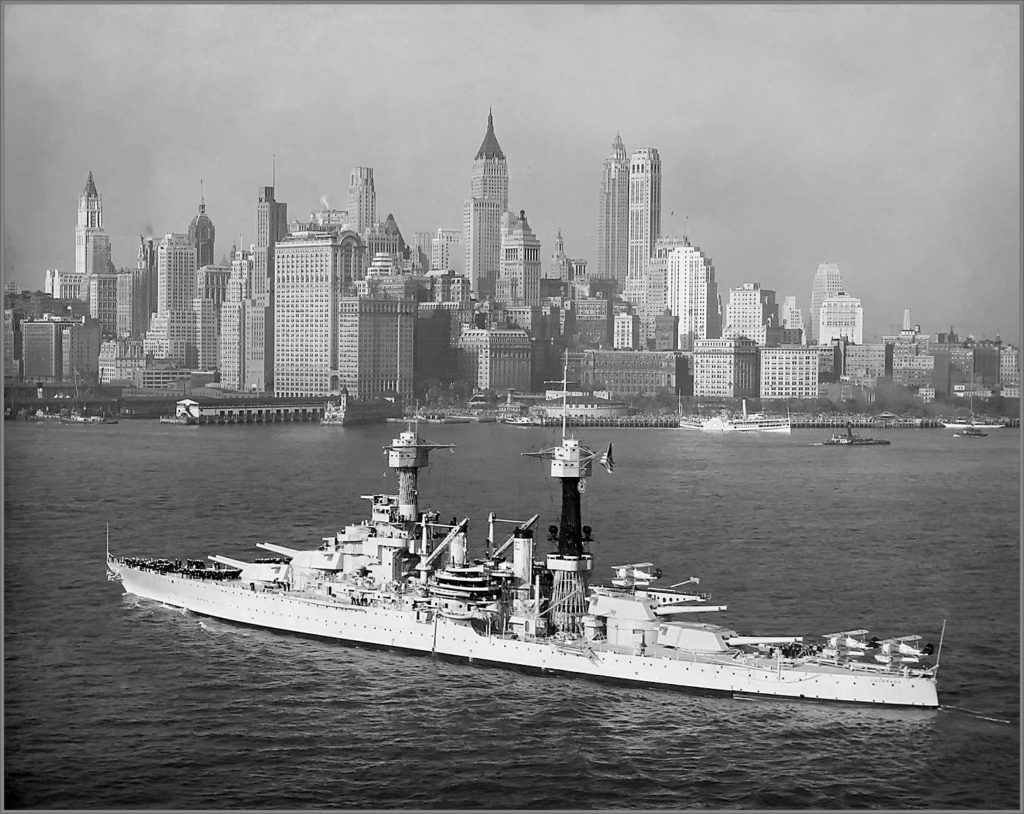
Colorado class in NY before the war
In 1922, their two rear 5-in roof guns were replaced by two 3-in (76 mm) guns. In 1928-28, modernization work led to the deletion of two submarine torpedo tubes. Armour scheme, in ‘all or nothing’ mode, included on decks, Battery, main and internal ones, measured 38-89-38 mm in thickness. Underwater protection consisted of three successive partitions of 19 mm close together, to diffract the energy of plunging shells.
These were filled with seawater to add an extra protection layer. Their remarkable powerplant at the time, experienced for the first time on the USS New Mexico in 1917 included four propellers, driven by two turbines, each powered by a turbo generator and two electric motors. Steam was provided by eight oil-fired boilers. One catapult was mounted on the aft ‘X’ turret and another on the stern. These were served by two goose neck cranes.
Four additional 4-in (76mm) AA guns were also mounted, and all of which were eliminated when the 5-in guns in single mounts of the battery deck were replaced with eight 5-in guns of a new model. In 1937-38, eleven Browning heavy machine guns (0.5 in) were placed on their decks. In 1941, the two ships, still showed their old corbel masts, spending years in the Pacific fleet, along with the other two California class. Together, they formed the most powerful asset of the US Navy in 1941, the “battleship row”, and the “big five” as the press spoke about it. It was in principle, a potent deterrent force towards Japan.
On December 6, 1941, USS West Virginia was testing with USS California the first radar mounted on American battleship. This Sunday however, both were disconnected, with the crew on leave as usual in peacetime. USS West Virginia was hit by 6 torpedoes and 2 bombs and sank straight in the harbour along with USS Maryland. USS Colorado fortunately was miles away in drydock.
It was not until May 1942 that USS West Virginia and Maryland were refitted and repaired. At last able to go to sea, they joined Puget Sound, the great arsenal of New York, spending two years in drydock for extensive repairs, redesign and modernization. When they came out, they differed, Colorado and Maryland being less completely transformed than USS West Virginia. All three received generous ASW ballast bulges. The hull was rebuilt and widened and the additional width helped fitting the eight twin 5-in turrets while the the superstructures were completely rebuilt in modern USN battleships standards, complete with new rangefinders, ballistic computer, and radars.
Colorado and Maryland kept their two funnels, and also their old corbel masts forward and aft, whereas USS West Virginia was rebuilt exactly like USS California. All three received a complementary AA battery, including the usual quad 40mm Bofors and and single 20 mm Oerlikon guns. USS Colorado kept its 8 single 5-in (127 mm) and received in addition 8 quadruple 40 mm AA, and 39 single 20 mm Oerlikon guns, just like Maryland. The latter was hit by a Kamikaze in 1945, repaired, rebuilt, gaining in the process the same eight twin 5-in AA standard turrets. At the same time, USS West Virgina received 58 single 20 mm guns, one twin double and one quadruple mount.
Of these three ships, USS West Virginia had a shorter career because of her long overhaul not ending until October 1944. The others were operational again in mid-43. They participated in most naval operations in the Pacific, and the battle of Leyte, where they were damaged by Kamikaze. USS West Viginia on her side became arguably the most successful rebuilt battleship of the US Navy, participating in the Battle of Lingayen in addition to that of Leyte, Iwo Jima and Okinawa. In June 1945 she received a bomb and a Kamikaze hit. In 1947, she was placed in reserve and remained mothballed until 1959. She was sold and BU in 1961, along with Colorado and Maryland.
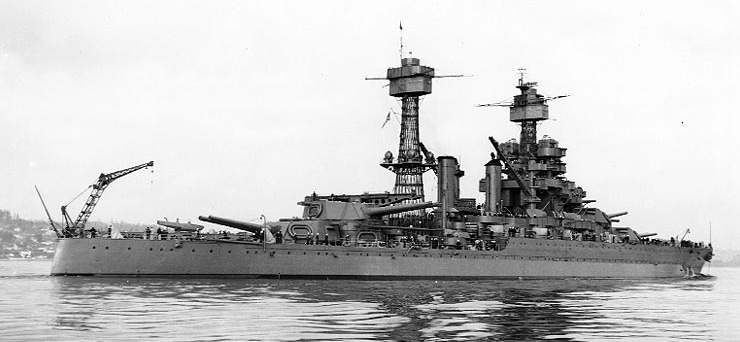
USS Maryland in 9 February 1942.
Characteristics (in 1944):
Displacement: 35,000 t. standard -40 340 t. Full Load
Dimensions: 190.2 m long, 34.75 m wide, 10.1 m draft
Machinery: 4 shaft 2 GM turbines, Electric motors, 8 Express Office boilers, 30,000 hp.
Top speed: 20.5 knots
Armor: From 356 mm (belt) to 406 mm conning tower and 457 mm turrets, decks 44-50 mm
Armament: 8 x 16-in, 8 x 2 5-in DP, 8 x 40 mm, 39-40 x 20 mm AA, see notes
North Carolina class battleships (1940)

USS North Carolina, leaving Norfolk in June 1942, bound for the Solomon Islands
The US Navy’s first “super-dreadnought” or “fast” battleship, USS North Carolina and Washington were the first battleships built since the Maryland in 1921, after the “vacancy” imposed by the Washington Treaty. This gap made it possible to work quietly on a project that was really developed from 1935. At that time, the admiralty desired more an evolution of the previous battleships than a real “fast battleship”, a perfect compromise between a battleship and a battlecruiser (see above, development of USN fast battleships). So speed was not the determining factor for these ships and finally settled at 28 knots. In retrospect, the following South Dakota made only 27 and a half knot, the first real “fast battleships” of the US Navy, were the four Iowa of 1943-44, capable of 30+ knots, battlecruiser speed.
Like the British Nelson class of 1925, the North Carolina class enjoyed a well studied protection, taking into account the new air threats and inner anti-torpedo protection, like massive ballasts designed at the origin. There was also a a logical evolution of the armament, from eight (four twin turrets) 16-in (406mm) to nine (3 triple turrets), with a longer barrel and improved mount for an improved range of nearly 40 000 meters, according to a standard configuration that will no longer evolve during the war.
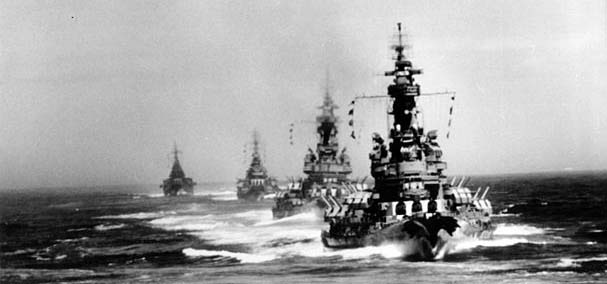
Secondary armament was fixed to the new 5-in (127 mm guns) twin turrets found on all US Navy ships and 40 mm Bofors and 20 mm Oerlikon guns were added later. They were tailored to deal with the four IJN Kongo class, gradually modernized and converted to fast battleships. In 1936, the Pacific fleet concentrated the largest means of the US Navy, and while diplomatic situation with Japan degenerated, the “big five” and a few other BBs remained a threat and a tempting target as well. Under the “escalation” clause of the London Treaty in 1931, turrets could could be modified to quadruple ones, carrying 355 mm guns instead. However the admiralty stuck to the 16-in caliber only because Japan refused to ratify these new limits. In addition, this caliber was the maximum allowed by the Washington Treaty, still operative.
Both ships were laid down in 1937 and 1938, and completed in 1941 (April and May). Their first missions were, although the US was not officially at war with Germany, to take part in the Atlantic convoys. There was little chance that German battleships would venture in US waters, but the US Navy had to protect the American trade in this part of the Atlantic nevertheless against any possible threat. Very early they experienced technical problems as their turbines generated strong vibrations. A month before the Pearl Harbor attack they were actually fully operational, all their teething problems has been ironed out.
In January 1942, they were sent urgently to the Pacific and were engaged at Guadalcanal, USS Washington engaging in a short duel with the IJN Kirishima. She participated in several battles in the area and Leyte in the Philippines in 1944. After the war ended they served in a semi-reserve status, alternating until 1961. USS Washington was eventually sold for BU on April 24, while USS North Carolina headed to Norfolk for her preservation, she is still here a museum ship, worth visiting today.
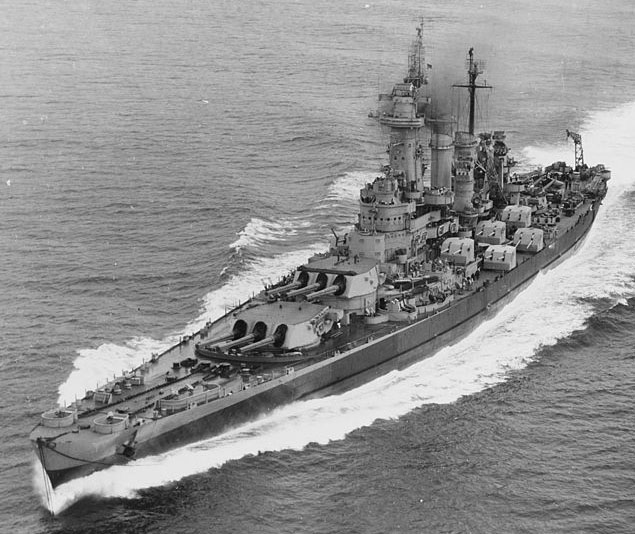
USS Washington (BB-56) at Puget Sound 10 Sept. 1945.
Characteristics (1941):
Displacement: 37,500 t. standard -44 377 t. Full Load
Dimensions: 222.12 m long, 33 m wide, 10 m draft
Machinery: 4 shaft GE turbines, 8 Babcock & Wilcox boilers, 121,000 hp. Top speed: 28 knots
Armour: 330-406 mm max
Armament: 9 x 406, 20 x 127 mm, 16 x 40 mm (3 x 4), 12 x 12.7 mm AA, 3 aircraft
Crew: 1,880
South Dakota class battleships (1942)

The USS Alabama, on patrol with the convoys of the Atlantic, December 1942, a few months after its commissioning
Long before the two Washington class entered service in 1941, since 1937, the US Navy planned to build new battleships as fast as the previous ones, but this time better protected, including against 16-in shells impacts, while retaining the same Washington treaty individual tonnage limit (35,000 tons). This quadrature of the circle was solved by reducing the general dimensions of the ship, keeping exactly the same armament as Washington class. The lack of space available however for the machinery was solved by adopting new innovative, if not revolutionary gear systems for the turbines. As a result, they still were capable of 28 knots, which was one knot more than the previous ones !
Generally regarded as very successful except perhaps the still limited speed, and bad habitability, these four ships, USS South Dakota (lead ship and class name), Indiana, Massachusetts and Alabama, were launched in 1941-42 and completed between March and August 1942. Engaged in the conflict early on, partly on the Atlantic (Murmansk convoys, and North Atlantic east and west) they also served during the whole Guadalcanal campaign and participated in the Philippines campaign. Their career holds nothing particularly glorious. They were removed from service and broken up in 1962-63, however USS Massachusetts and Alabama were preserved for posterity and were turned to museum ships.

USS Alabama at Casco bay 1942, showing the popular patched camouflage at that time.
Characteristics (1942):
Displacement: 38,000 t. standard -44 520 t. Full Load
Dimensions: 207.26 m long, 33 m wide, 10.7 m draft
Machines: 4 propellers, 4 GE turbines, 8 Babcock & Wilcox boilers, 130,000 hp.
Maximum speed: 27.5 knots
Shield: 330-406 mm max
Weaponry: 9 guns of 406, 20 guns of 127 mm, 12 guns of 40 mm (3 x 4), 16 of 20 mm AA, 3 planes
Crew: 1,793
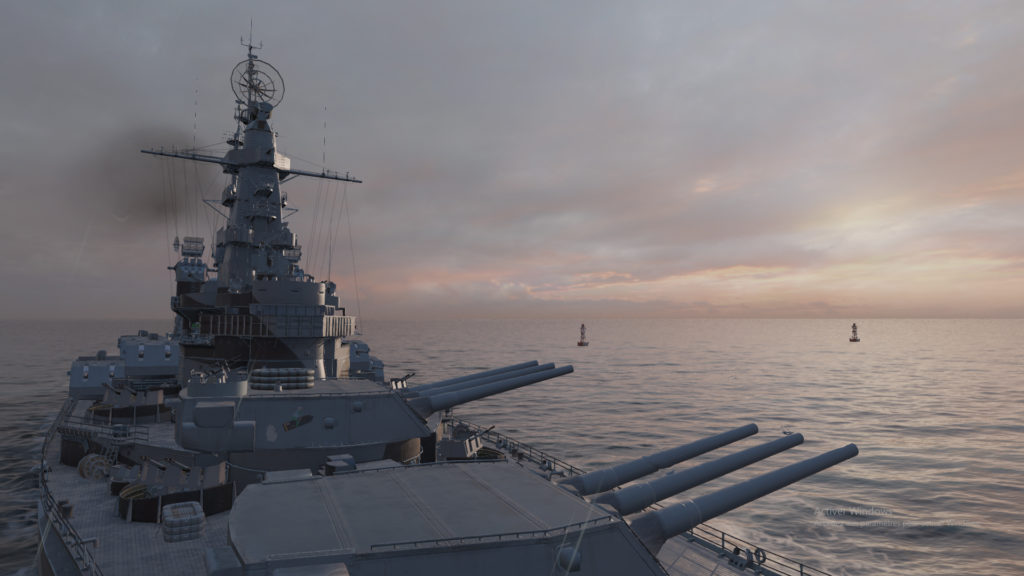
Front battery of USS Massachusetts, 1944 (wow)
Iowa class battleships (1944)

The fast battleship USS Missouri in 1944, shortly after the Battle of Leyte.
The Iowa class battleships formed a new generation of fast battleships, initiated by the Washington in 1940, but implementing a speed increase that was only possible in wartime, as displacement was off limits, off treaties. The previous South Dakota tried to combine their armament by improving protection and thus sacrificing length to that and were still relatively ‘slow’ at 27.5 knots. The Iowas however, with a total planned of 6 ships, had to have a better speed by giving considerable added space to the machinery.
As a result, they were lying to the extreme, jumping from 207 to 270 meters long. Taken from above, the three classes looked like indeed the same design stretched out… This considerable space saving also allowed to improve living quarters, to manage additional spaces for the AA, fuel, and to offer them a far superior arc of fire thanks to turrets further apart. Finally, larger turrets also allowed to use 16-in gins of 45 caliber thanks to a better stability. Top speed, now with 212,000 hp instead of 130,000, jumped to 32.5 knots instead of 27.5 knots. This allowed them to better integrate into fast carrier task forces which ruled the waves by 1944.
The original Iowa class included the USS Iowa, New Jersey, Wisconsin, Missouri, Illinois and Kentucky, but the latter two, which construction started in December 1942, were cancelled underway on August 11, 1945, shortly after the surrender. USS Kentucky was even launched on January 20, 1950 to clear the drydock and be broken up. Also the conversion projects into missile battleships were abandoned for both. Therefore only the first four units were completed and commissioned in Feb.-April 1943 (Iowa, New Jersey), and April-June 1944 for the other two.
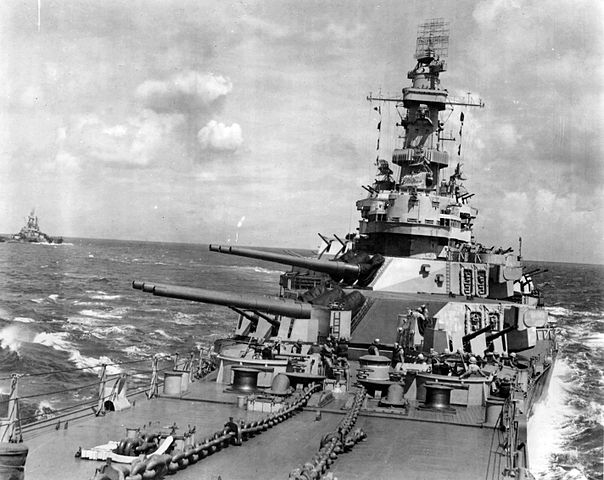
They weighed 57,000 tons fully load, way above the 45.000 tons 1935 London limit, which was exceptional and placed them at the top of the list of the world’s largest warships ever. However, their nominated opponents, the two Japanese Yamato, with their 80,000 tons and their 18-in guns, outclassed them. But the Admiralty did not plan to move to a higher caliber, even for the planned Montana (70,000 tons) alongside the Iowa and cancelled in 1943. It must be said that these calibers had a useful range of 40,000 meters, which remains exceptional and reached the limits of eye-guiding skills, despite the use of radars and spotting planes.
The Iowa class ships participated actively in the conflict and immediately after to the Korean War, providing quality fire support, before being put in reserve, as their maintenance was expensive and they reached the limits of their operational usefulness. After all in the 1960s, battleships were all but dinosaurs when a missile cruiser can make much more damage at greater range. They will be reactivated however again during the Vietnam War, joined the reserve in 1973, and emerged again intensively modernized, in 1984.
The spur for this was the new cold of the Reagan era, after the scare caused by the launch of the Soviet Kirov class “battlecruisers”. These ships indeed were missile cruisers of a size and armament that surpassed any known opponents. They reopened the forgotten case of the ‘capital ship’ as defined before WW2. This reconstruction was so radical it will be seen in the cold war section. The four Iowa class battleships still exist all four as museum ships, some rendered to their original WW2 aspect. They were decommissioned after the Gulf war in 1990, their last wartime action.
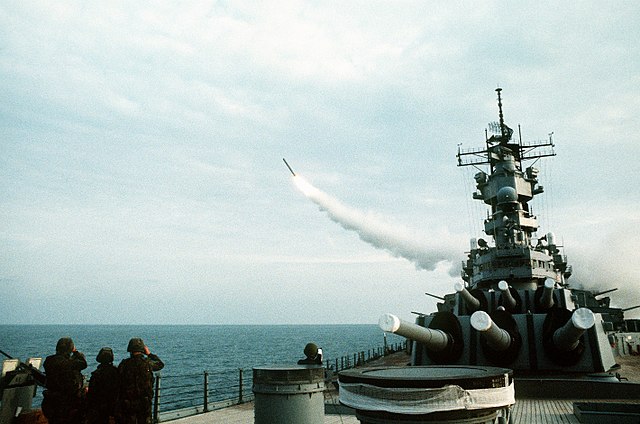
USS Wisconsin firing a Tomahawk cruise missile during the gulf war, the last action of the four venerated relics of WW2. They were not technically “missile battleships” since they were not rebuilt to integrate missile racks instead of their main artillery. This category, going on full missile armament with the armour of a battleship, was often proposed, notably as a modernization plan for obsolete battleships from the three classes in reserve, and reactivated with the reveal of the Kirov class in 1980. That’s a long debate, feel free to participate in it.
Characteristics (1944):
Displacement: 48,110 t. standard -57,540 t. Full Load
Dimensions: 270.4 m long, 33 m wide, 11 m draft
Machines: 4 propellers, 4 GE turbines, 8 Babcock & Wilcox boilers, 212,000 hp.
Maximum speed: 32.5 knots
Shield: Belt 305, turrets 482, bridges 152, inner casemate 287-440 mm, blockhouse 445
Weaponry: 12 guns of 406 (3 × 3), 20 of 127 (10 × 2), 80 guns of 40 (20 × 4), 49 of 20 mm AA, 3 planes
Crew: 1,921

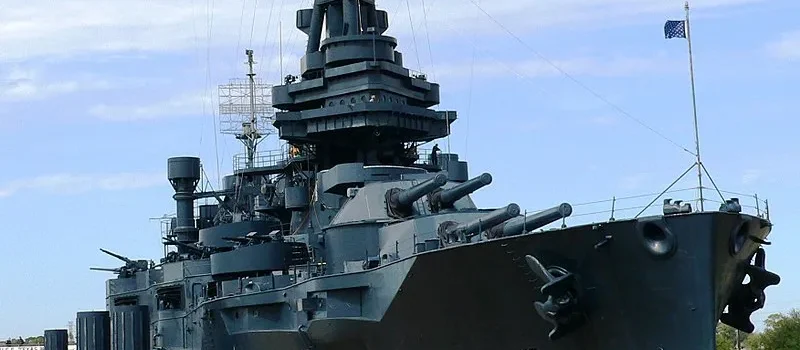

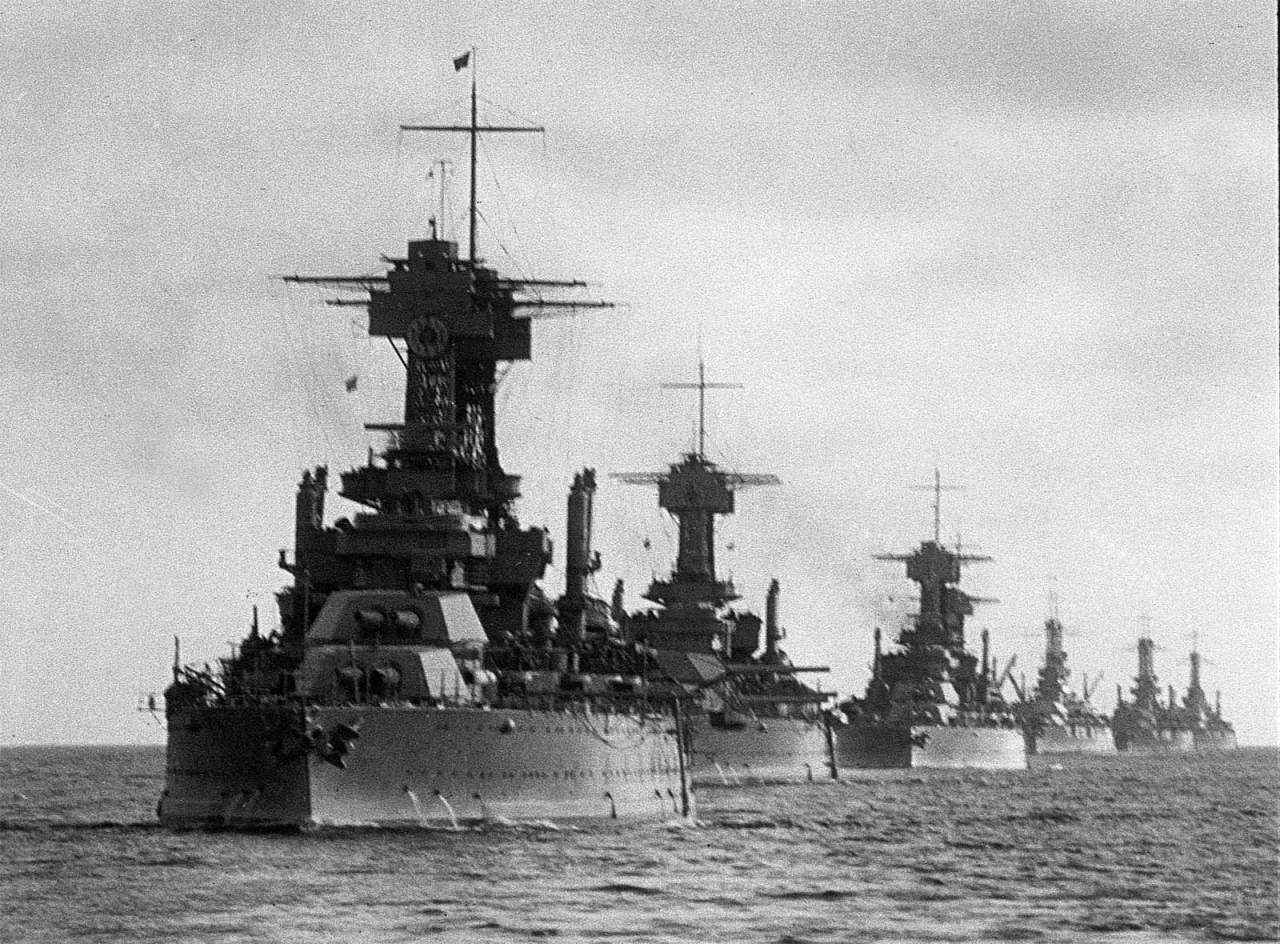
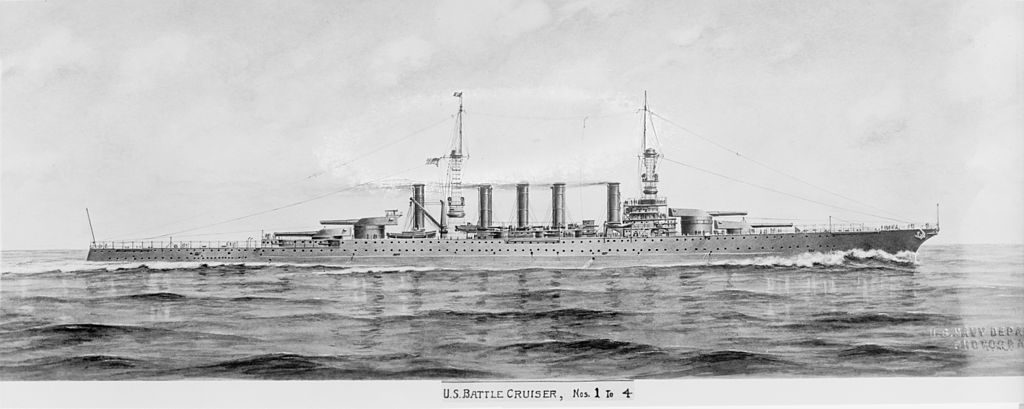
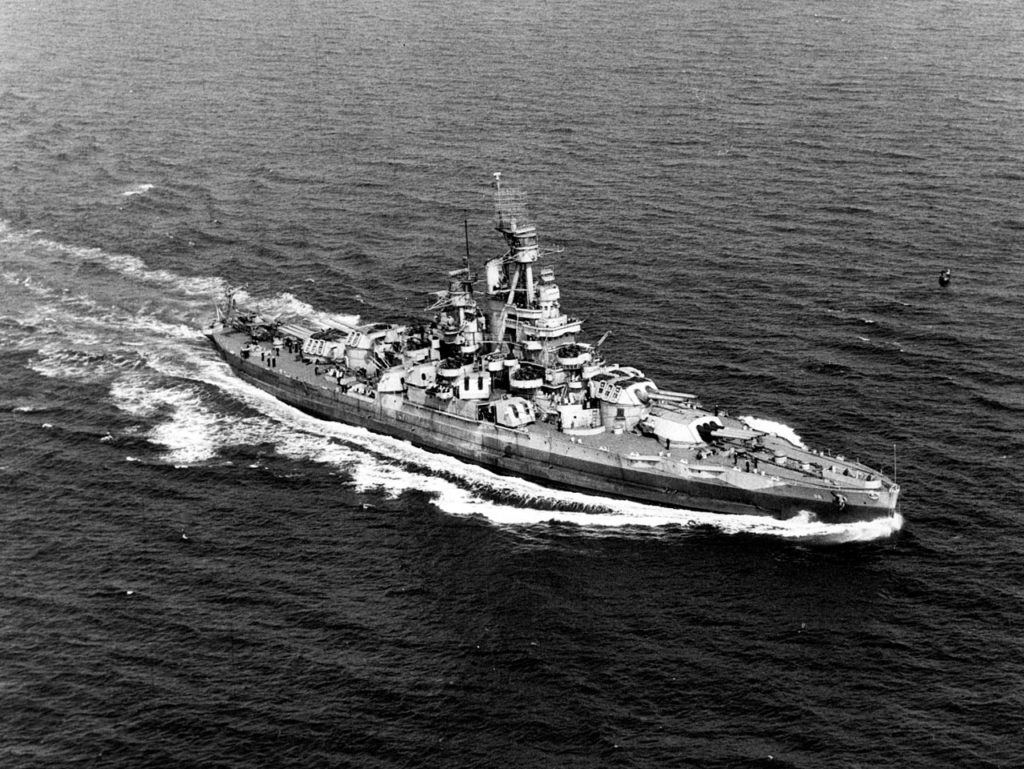
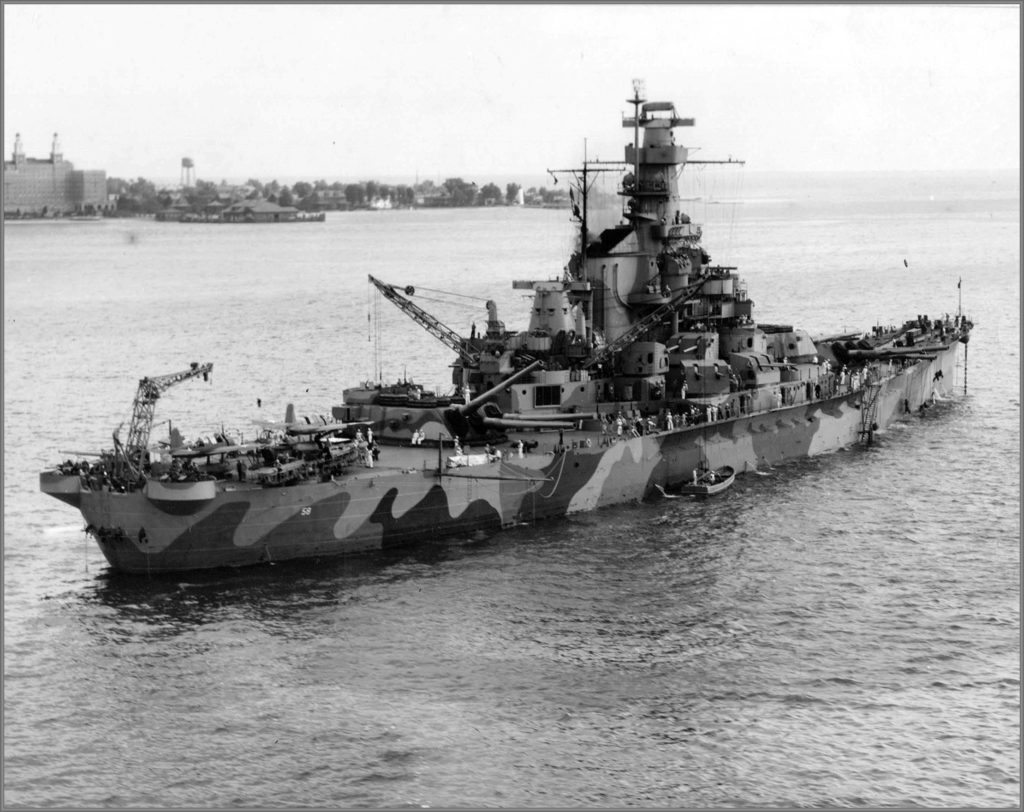
 Latest Facebook Entry -
Latest Facebook Entry -  X(Tweeter) Naval Encyclopedia's deck archive
X(Tweeter) Naval Encyclopedia's deck archive Instagram (@navalencyc)
Instagram (@navalencyc)





 French Navy
French Navy Royal Navy
Royal Navy Russian Navy
Russian Navy Armada Espanola
Armada Espanola Austrian Navy
Austrian Navy K.u.K. Kriegsmarine
K.u.K. Kriegsmarine Dansk Marine
Dansk Marine Nautiko Hellenon
Nautiko Hellenon Koninklije Marine 1870
Koninklije Marine 1870 Marinha do Brasil
Marinha do Brasil Osmanlı Donanması
Osmanlı Donanması Marina Do Peru
Marina Do Peru Marinha do Portugal
Marinha do Portugal Regia Marina 1870
Regia Marina 1870 Nihhon Kaigun 1870
Nihhon Kaigun 1870 Preußische Marine 1870
Preußische Marine 1870 Russkiy Flot 1870
Russkiy Flot 1870 Svenska marinen
Svenska marinen Søværnet
Søværnet Union Navy
Union Navy Confederate Navy
Confederate Navy Armada de Argentina
Armada de Argentina Imperial Chinese Navy
Imperial Chinese Navy Marinha do Portugal
Marinha do Portugal Mexico
Mexico Kaiserliche Marine
Kaiserliche Marine 1898 US Navy
1898 US Navy Sovietskiy Flot
Sovietskiy Flot Royal Canadian Navy
Royal Canadian Navy Royal Australian Navy
Royal Australian Navy RNZN Fleet
RNZN Fleet Chinese Navy 1937
Chinese Navy 1937 Kriegsmarine
Kriegsmarine Chilean Navy
Chilean Navy Danish Navy
Danish Navy Finnish Navy
Finnish Navy Hellenic Navy
Hellenic Navy Polish Navy
Polish Navy Romanian Navy
Romanian Navy Turkish Navy
Turkish Navy Royal Yugoslav Navy
Royal Yugoslav Navy Royal Thai Navy
Royal Thai Navy Minor Navies
Minor Navies Albania
Albania Austria
Austria Belgium
Belgium Columbia
Columbia Costa Rica
Costa Rica Cuba
Cuba Czechoslovakia
Czechoslovakia Dominican Republic
Dominican Republic Haiti
Haiti Hungary
Hungary Honduras
Honduras Estonia
Estonia Iceland
Iceland Eire
Eire Equador
Equador Iran
Iran Iraq
Iraq Latvia
Latvia Liberia
Liberia Lithuania
Lithuania Mandchukuo
Mandchukuo Morocco
Morocco Nicaragua
Nicaragua Persia
Persia San Salvador
San Salvador Sarawak
Sarawak Uruguay
Uruguay Venezuela
Venezuela Zanzibar
Zanzibar Warsaw Pact Navies
Warsaw Pact Navies Bulgaria
Bulgaria Hungary
Hungary

 Bundesmarine
Bundesmarine Dutch Navy
Dutch Navy Hellenic Navy
Hellenic Navy Marina Militare
Marina Militare Yugoslav Navy
Yugoslav Navy Chinese Navy
Chinese Navy Indian Navy
Indian Navy Indonesian Navy
Indonesian Navy JMSDF
JMSDF North Korean Navy
North Korean Navy Pakistani Navy
Pakistani Navy Philippines Navy
Philippines Navy ROKN
ROKN Rep. of Singapore Navy
Rep. of Singapore Navy Taiwanese Navy
Taiwanese Navy IDF Navy
IDF Navy Saudi Navy
Saudi Navy Royal New Zealand Navy
Royal New Zealand Navy Egyptian Navy
Egyptian Navy South African Navy
South African Navy






























 Ukrainian Navy
Ukrainian Navy dbodesign
dbodesign
Hey the “Wyoming class of 1913” is the New York class and not the Wyoming. Wyoming was the class before that.
Hello Reuben
That was indeed the NY class, as i previously mentioned the Wyoming of 1911; Well spotted sir !
Also the Nevada class is the class with twin-triple turret Lay-out not the Pennsylvania That was the first design to have all triple turrets
I saw the error in brackets, well spotted too, it’s fixed.
Hi, no such thing as the Alabama-Class. She was the 4th in the South Dakota (BB-57) Class. Nice otherwise.
Fixed, indeed that was an heritage of the old post. Thx Ann-Marie !
Class naming is sometimes odd, but yes, South Dakota was unquestionably the lead ship as launched in June 1941, the second being the Massachusetts (September) -although she was BB59-, Indiana in November and ‘Bama in Feb. 1942, completed also in August of the same year whereas the three others were out in March, April and May respectively. That was very quick for battleships BTW.
I love the Montana class battleship but… sadly it was never made. Just a keel was made would have made me happy because there’s proof that it was planned to be built.
A lot have been written about it, and it will make a nice post in 2021, no doubt !
All the best
U.S.S Arizona
Stond in Pearl Harbor (Hawaii)
De Japanners kwamen aan op Pearl Harbor ze bombardeerde de Amerikaanse schepen dit deeden ze om Amerika 🇺🇸 buiten spel te zetten maar dat werkte zo niet er kwam oorlog de pasific war en de U.S.S Arizona was kapot gebombardeerd er is een herdenkings punt bij Pearl Harbor daar kun je de U.S.S Arizona zien
The North Carolina is not in Norfolk, Va, but is in Wilmington, North Carolina.
“USS Wyoming was rearmed in New York with a particularly powerful AA, participating in the landings in Normandy (Overlord) and that of Provence (Anvil). They were then sent into the Pacific, covering the operations of Iwo Jima and Okinawa. Set aside in August 1945, USS Wyoming ended her days blasted in the Bikini nuclear test (Operation Crossroad).”
Arkansas was at Normandy, and went to the Pacific and was used as a test target. Wyoming never left the training role in the States and was sold for scrap in 1947.
Thanks fixed, they were mixed up, very old translation of an even older post.
I believe you have West Virginia 1944 and Maryland 1943 pictures reversed. Maryland was not near as altered as West Virginia late in the war
Hello Rick, that’s right, they were inverted, thx for spotting it !